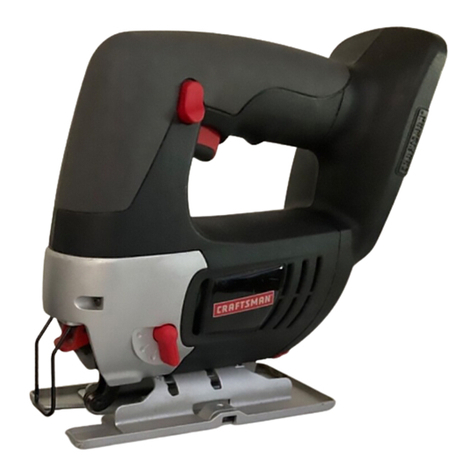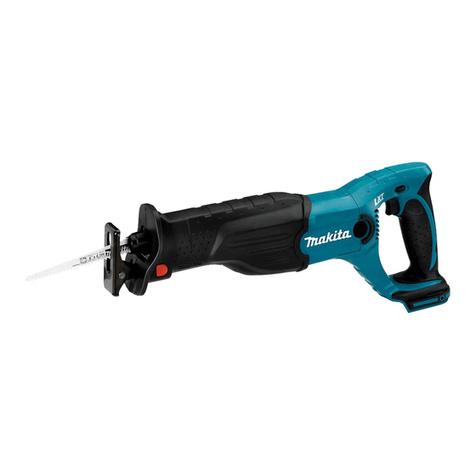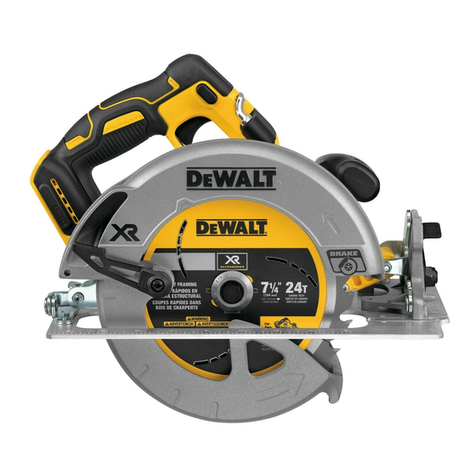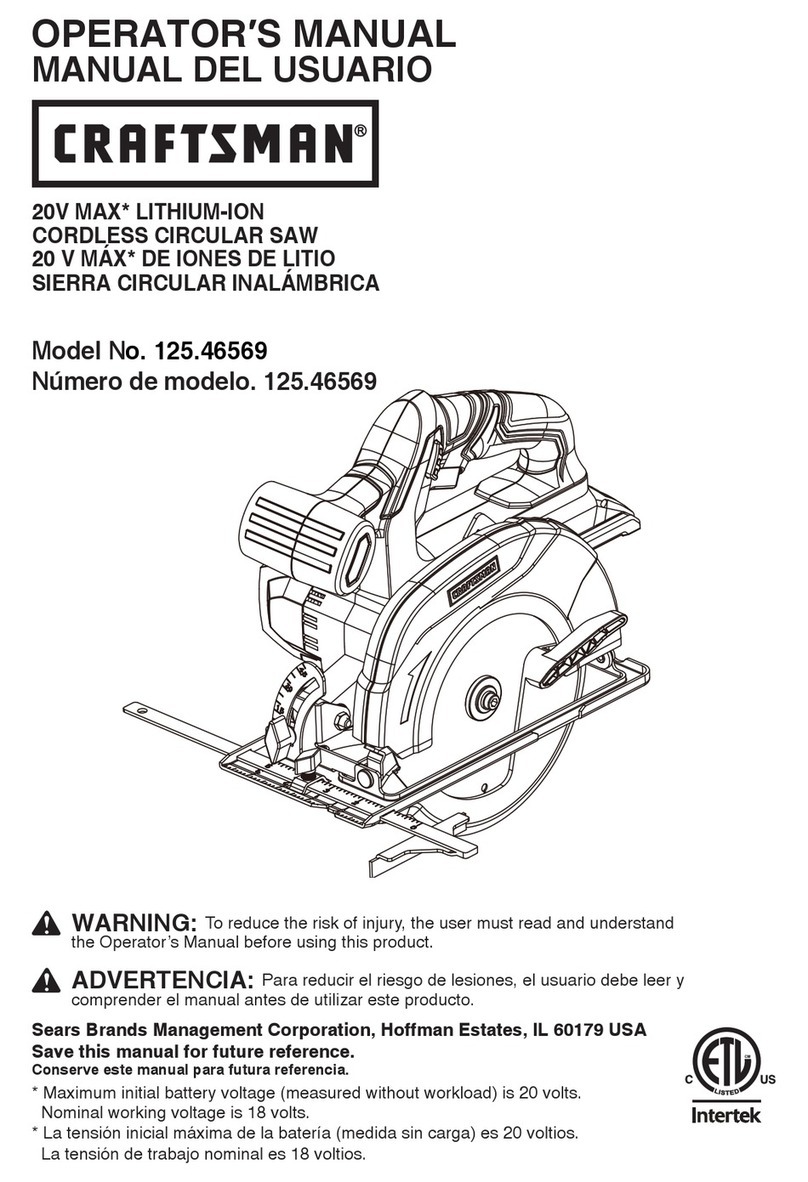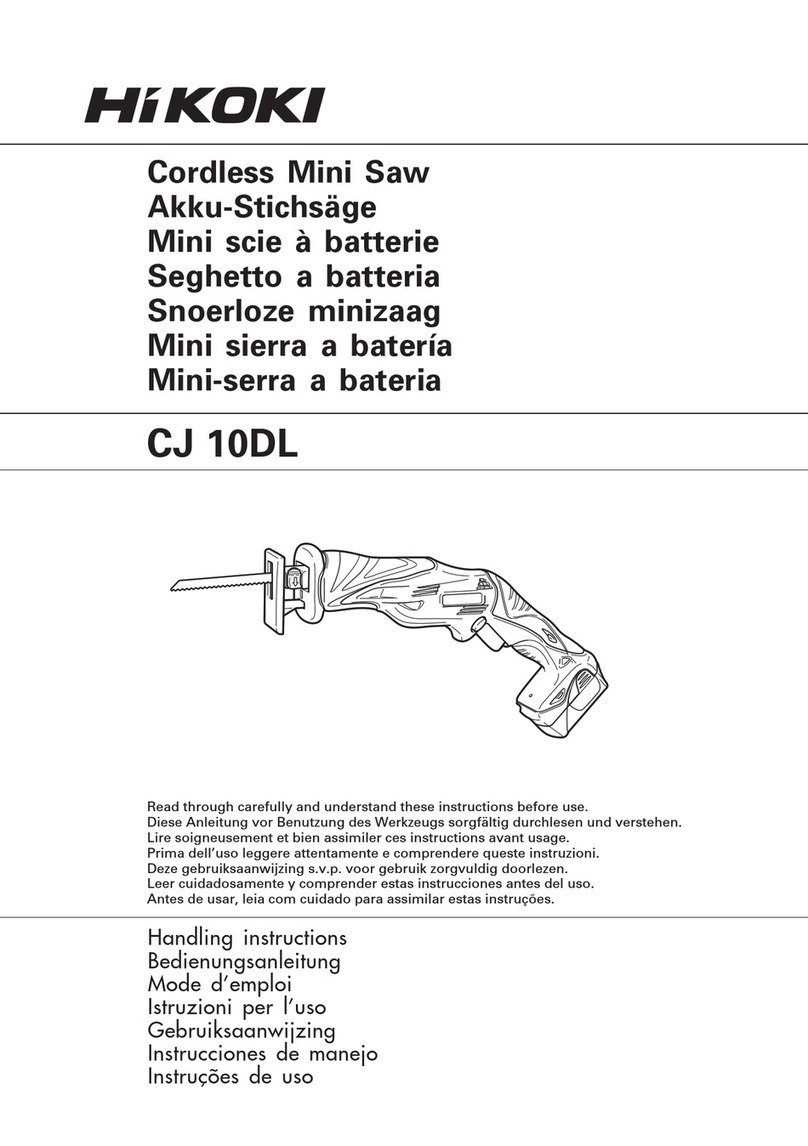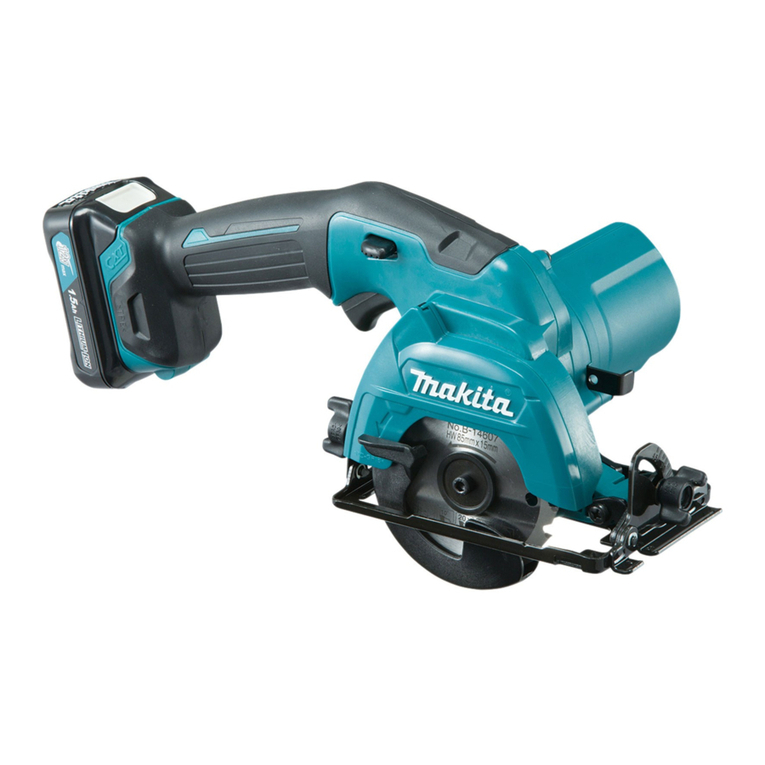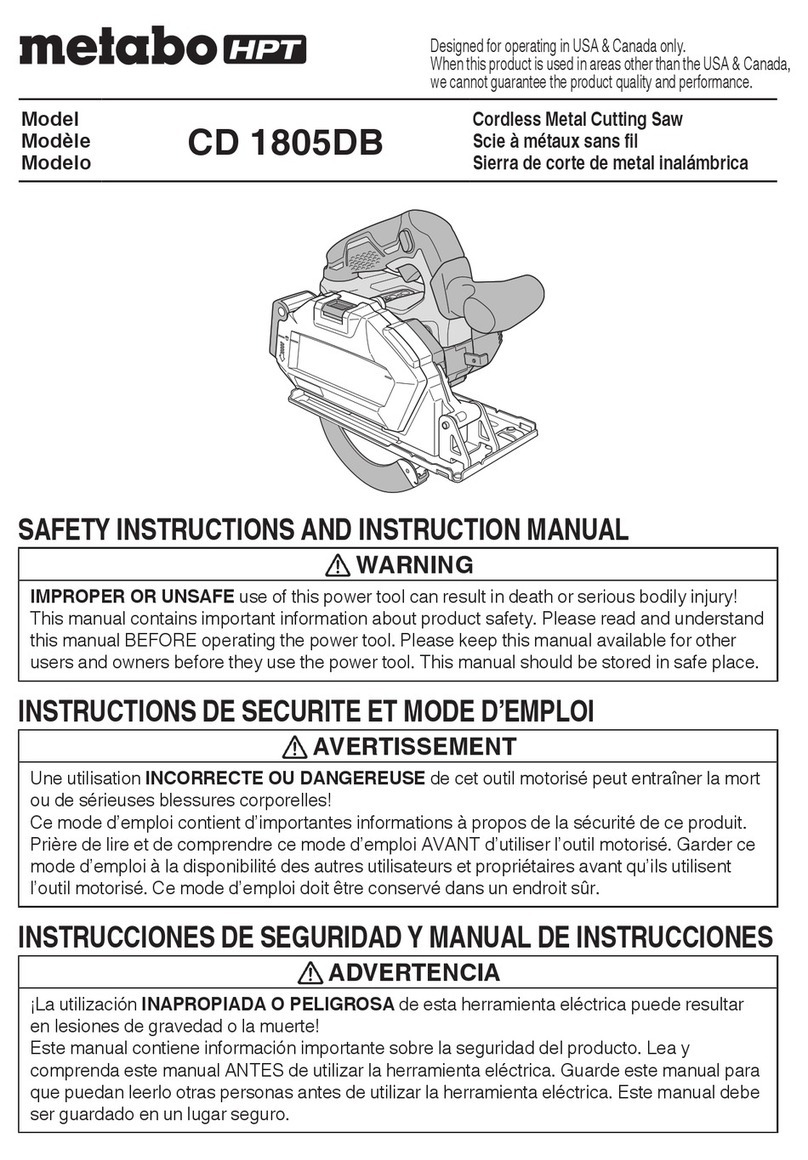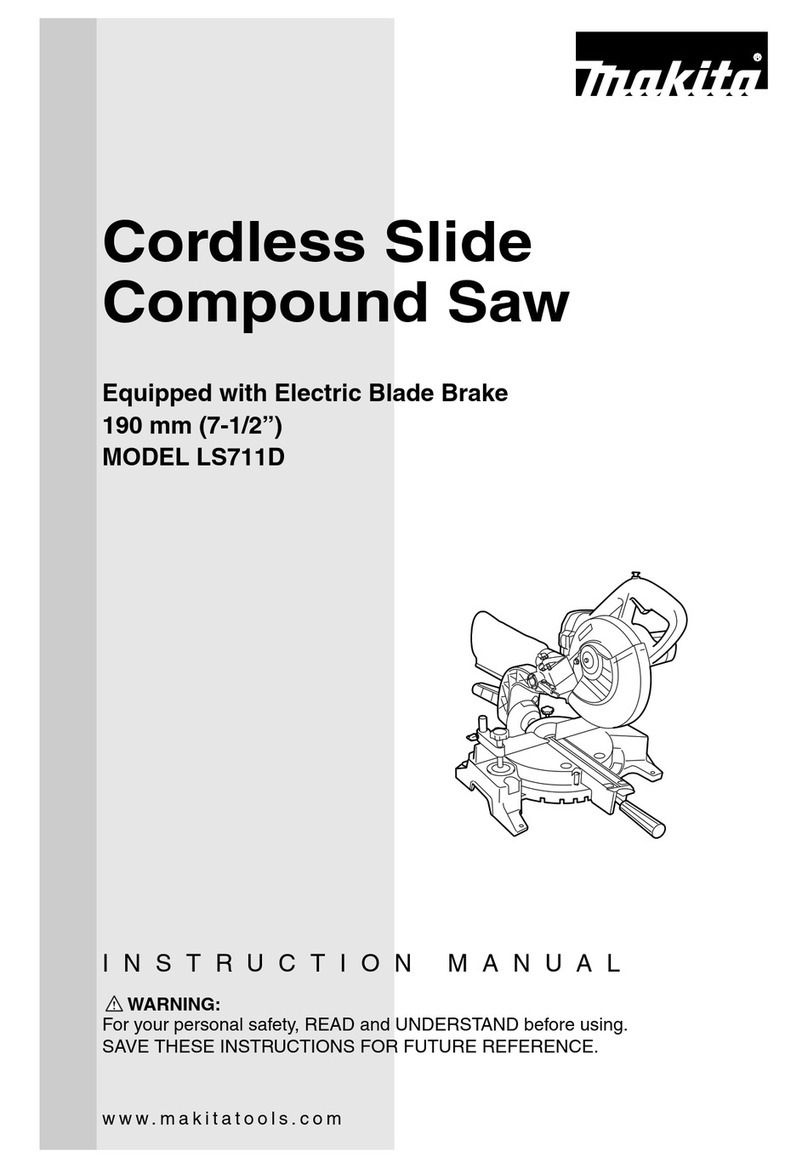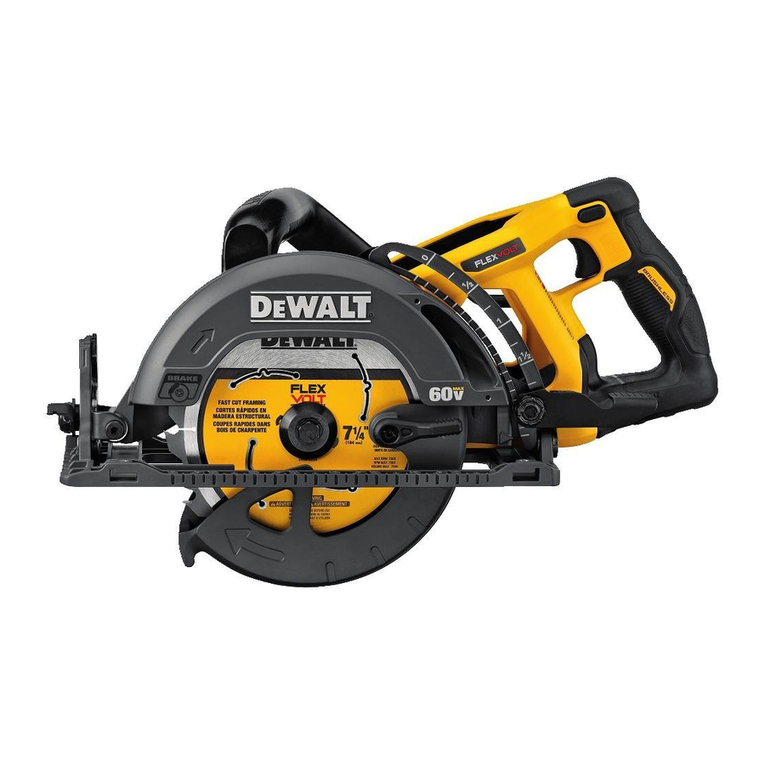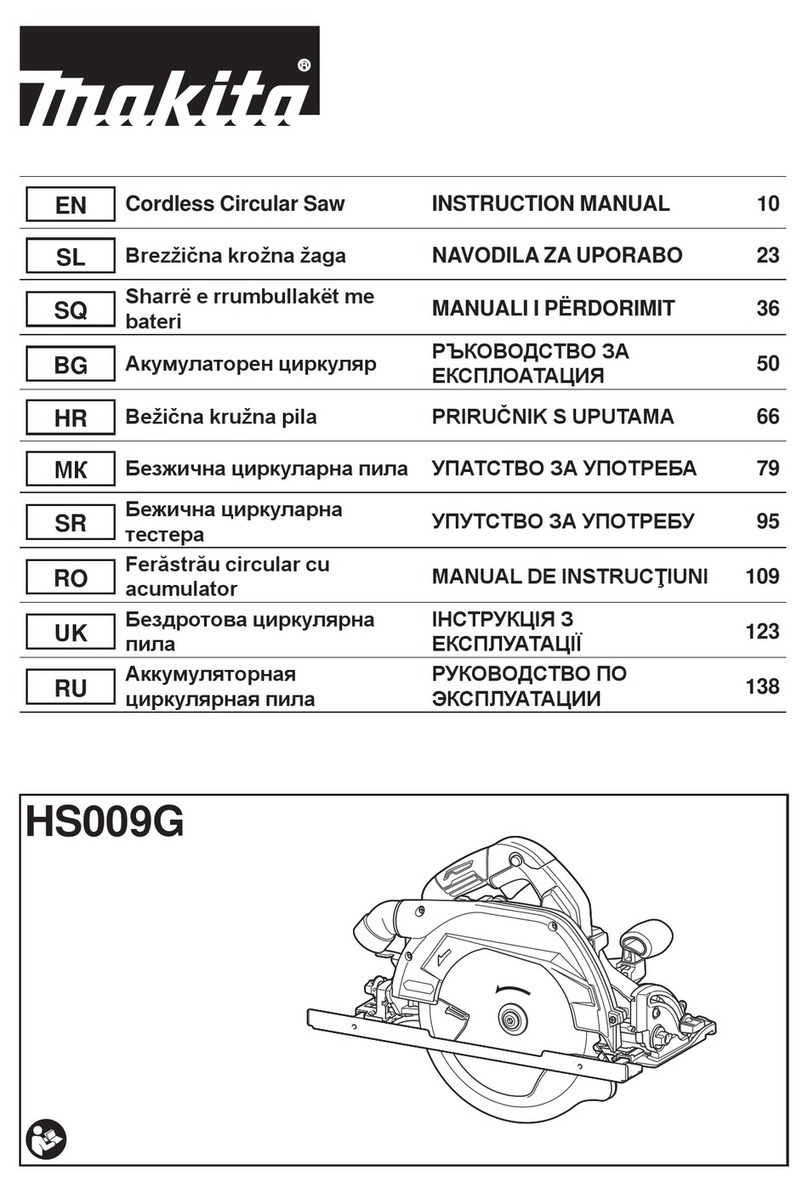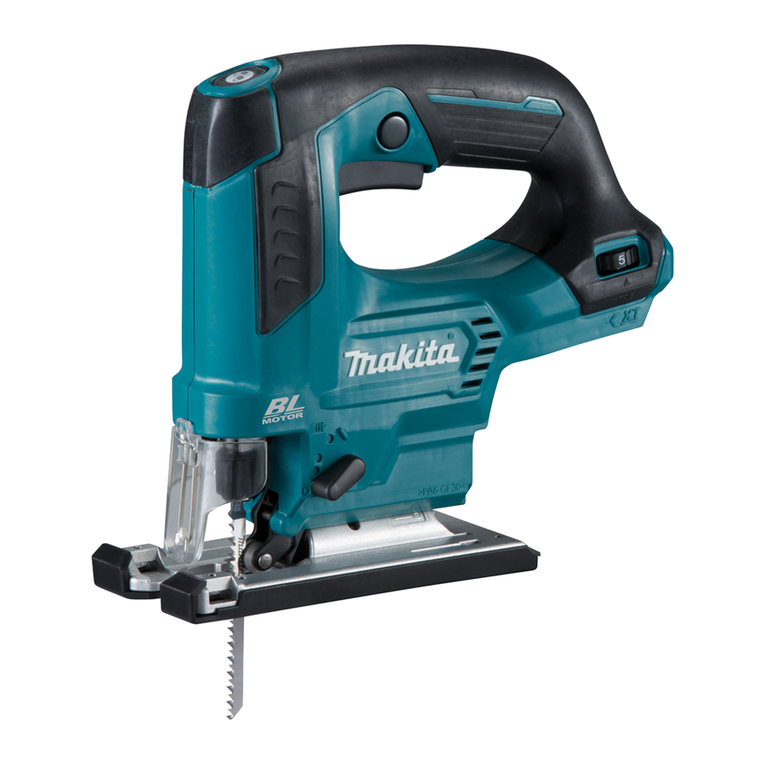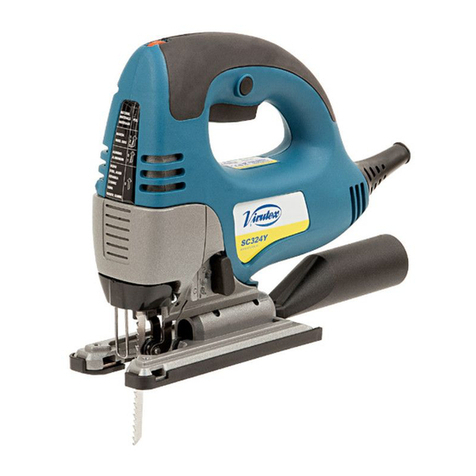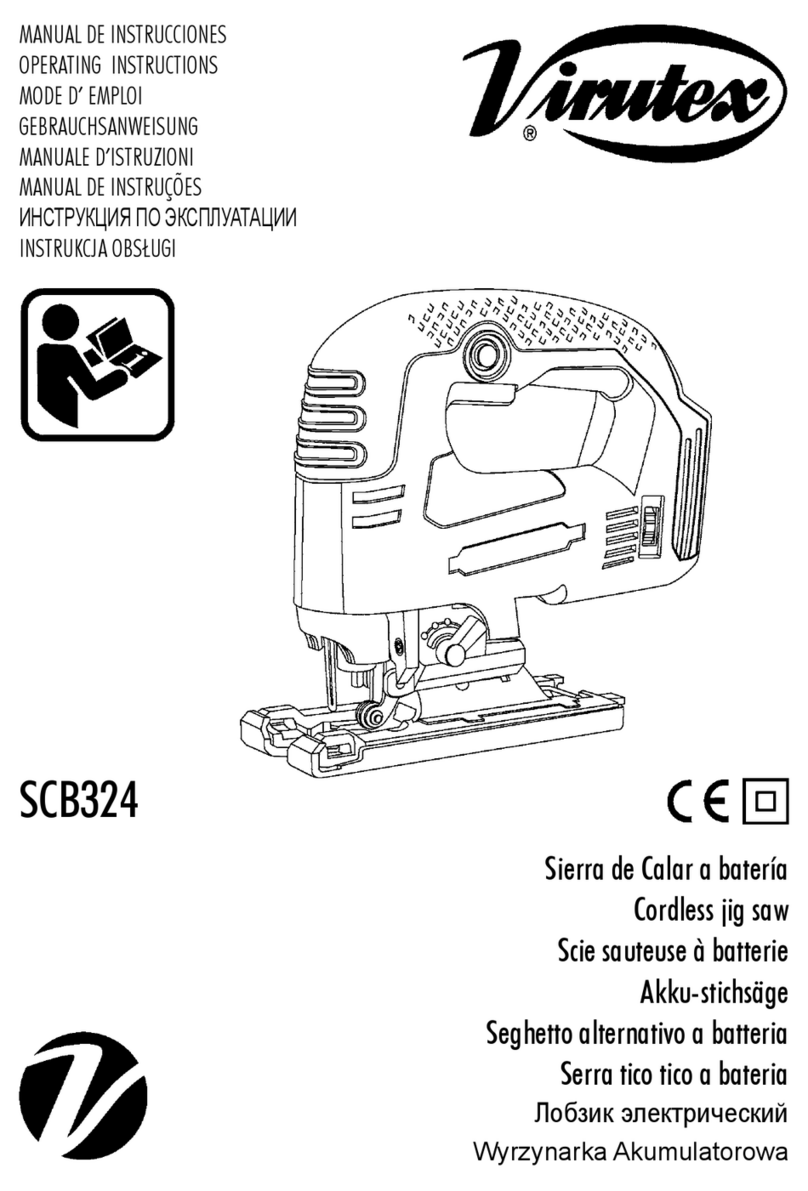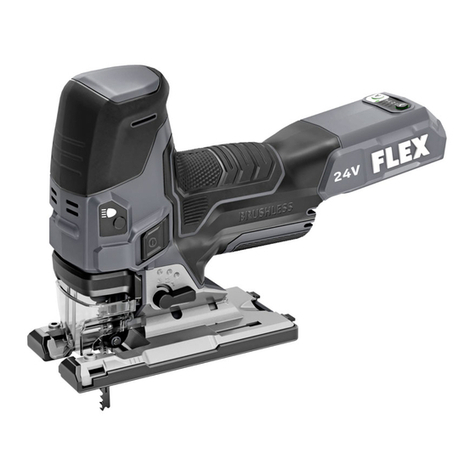Porter-Cable PCC650B User manual

www.portercable.com
Batteries and chargers sold separately.
Blocs-piles et chargeurs vendus séparément.
Las baterías y los cargadores se venden por separado.
INSTRUCTIVO DE OPERACIÓN, CENTROS DE
SERVICIO Y PÓLIZA DE GARANTÍA.
ADVERTENCIA: LÉASE ESTE INSTRUCTIVO
ANTES DE USAR EL PRODUCTO.
*Maximum initial battery pack voltage (measured without a workload) is 20 volts. The nominal voltage is 18.
*La tension initiale maximale du bloc-piles (mesurée sans charge de travail) est de 20 volts. La tension
nominale est de 18.
*El máximo voltaje inicial del paquete de baterías (medido sin una carga de trabajo) es 20 voltios. La
tensión nominal es de 18.
20v Max* Lithium Jig Saw
Scie sauteuse sans fil á block-piles au lithium-ion de 20v Max*
Sierra caladora inalámbrica de iones de litio de 20v Max*
CATALOG NUMBER
N° DE CATALOGUE
CATÁLOGO N°
PCC650
Instruction manual
Manuel d’instructions
Manual de’instrucciones

2
F
B
D
C
H
G
EA 2
1
3
4
6
3
E1
F1
F2
G1
5
C1

3
SAFETY GUIDELINES - DEFINITIONS
It is important for you to read and understand this manual. The information it contains
relates to protecting YOUR SAFETY and PREVENTING PROBLEMS. The symbols
below are used to help you recognize this information.
DANGER: Indicates an imminently hazardous situation which, if not avoided,
will result in death or serious injury.
WARNING: Indicates a potentially hazardous situation which, if not avoided,
could result in death or serious injury.
CAUTION: Indicates a potentially hazardous situation which, if not avoided,
may result in minor or moderate injury.
NOTICE: Used without the safety alert symbol indicates potentially hazardous
situation which, if not avoided, may result in property damage.
GENERAL POWER TOOL SAFETY WARNINGS
WARNING: Read all safety warnings and all instructions. Failure to follow the
warnings and instructions may result in electric shock, fire and/or serious injury.
SAVE ALL WARNINGS AND INSTRUCTIONS FOR FUTURE REFERENCE
The term “power tool” in the warnings refers to your mains-operated (corded) power tool
or battery-operated (cordless) power tool.
1) WORK AREA SAFETY
a) Keep work area clean and well lit. Cluttered or dark areas invite accidents.
b)
Do not operate power tools in explosive atmospheres, such as in the presence of flammable
liquids, gases or dust. Power tools create sparks which may ignite the dust or fumes.
c) Keep children and bystanders away while operating a power tool. Distractions
can cause you to lose control.
2) ELECTRICAL SAFETY
a) Power tool plugs must match the outlet. Never modify the plug in any
way. Do not use any adapter plugs with earthed (grounded) power tools.
Unmodified plugs and matching outlets will reduce risk of electric shock.
b) Avoid body contact with earthed or grounded surfaces such as pipes, radiators,
ranges and refrigerators. There is an increased risk of electric shock if your body is
earthed or grounded.
c) Do not expose power tools to rain or wet conditions. Water entering a power
tool will increase the risk of electric shock.
d) Do not abuse the cord. Never use the cord for carrying, pulling or
unplugging the power tool. Keep cord away from heat, oil, sharp edges or
moving parts. Damaged or entangled cords increase the risk of electric shock.
e)
When operating a power tool outdoors, use an extension cord suitable for
outdoor use. Use of a cord suitable for outdoor use reduces the risk of electric shock.
f)
If operating a power tool in a damp location is unavoidable, use a ground fault circuit
interrupter (GFCI) protected supply. Use of a GFCI reduces the risk of electric shock.
3) PERSONAL SAFETY
a) Stay alert, watch what you are doing and use common sense when operating
a power tool. Do not use a power tool while you are tired or under the
influence of drugs, alcohol or medication. A moment of inattention while
operating power tools may result in serious personal injury.
b) Use personal protective equipment. Always wear eye protection. Protective
equipment such as dust mask, nonskid safety shoes, hard hat, or hearing
protection used for appropriate conditions will reduce personal injuries.
c) Prevent unintentional starting. Ensure the switch is in the off position before
connecting to power source and/ or battery pack, picking up or carrying the
tool. Carrying power tools with your finger on the switch or energizing power tools
that have the switch on invites accidents.
d)
Remove any adjusting key or wrench before turning the power tool on. A wrench
or a key left attached to a rotating part of the power tool may result in personal injury.
e) Do not overreach. Keep proper footing and balance at all times. This enables
better control of the power tool in unexpected situations.

4
f)
Dress properly. Do not wear loose clothing or jewelry. Keep your hair, clothing and gloves
away from moving parts. Loose clothes, jewelry or long hair can be caught in moving parts.
g)
If devices are provided for the connection of dust extraction and collection facilities, ensure
these are connected and properly used. Use of dust collection can reduce dust-related hazards.
4) POWER TOOL USE AND CARE
a)
Do not force the power tool. Use the correct power tool for your application. The
correct power tool will do the job better and safer at the rate for which it was designed.
b) Do not use the power tool if the switch does not turn it on and off. Any power
tool that cannot be controlled with the switch is dangerous and must be repaired.
c) Disconnect the plug from the power source and/or the battery pack from the
power tool before making any adjustments, changing accessories, or storing
power tools. Such preventive safety measures reduce the risk of starting the
power tool accidentally.
d) Store idle power tools out of the reach of children and do not allow persons
unfamiliar with the power tool or these instructions to operate the power
tool. Power tools are dangerous in the hands of untrained users.
e) Maintain power tools. Check for misalignment or binding of moving parts, breakage
of parts and any other condition that may affect the power tool’s operation. If
damaged, have the power tool repaired before use. Many accidents are caused by
poorly maintained power tools.
f) Keep cutting tools sharp and clean. Properly maintained cutting tools with sharp
cutting edges are less likely to bind and are easier to control.
g) Use the power tool, accessories and tool bits, etc. in accordance with these
instructions, taking into account the working conditions and the work to be
performed. Use of the power tool for operations different from those intended could
result in a hazardous situation.
5) BATTERY TOOL USE AND CARE
a) Recharge only with the charger specified by the manufacturer. A charger that
is suitable for one type of battery pack may create a risk of fire when used with
another battery pack.
b) Use power tools only with specifically designated battery packs. Use of any
other battery packs may create a risk of injury and fire.
c) When battery pack is not in use, keep it away from other metal objects like
paper clips, coins, keys, nails, screws, or other small metal objects that can
make a connection from one terminal to another. Shorting the battery terminals
together may cause burns or a fire.
d) Under abusive conditions, liquid may be ejected from the battery, avoid
contact. If contact accidentally occurs, flush with water. If liquid contacts
eyes, additionally seek medical help. Liquid ejected from the battery may cause
irritation or burns.
6) SERVICE
a)
Have your power tool serviced by a qualified repair person using only identical
replacement parts. This will ensure that the safety of the power tool is maintained.
JIG SAW SAFETY WARNINGS
• Hold power tool by insulated gripping surfaces, when performing an operation
where the cutting accessory may contact hidden wiring. Cutting accessory
contacting a “live” wire may make exposed metal parts of the power tool “live” and could
give the operator an electric shock.
• Use clamps or another practical way to secure and support the workpiece to a
stable platform. Holding the work by hand or against your body leaves it unstable
and may lead to loss of control.
•Keep hands away from cutting area. Never reach underneath the material for any
reason. Hold front of saw by grasping the contoured gripping area. Do not insert
fingers or thumb into the vicinity of the reciprocating blade and blade clamp. Do not
stabilize the saw by gripping the shoe.
• Keep blades sharp. Dull blades may cause the saw to swerve or stall under pressure.
• Use extra caution when cutting overhead and pay particular attention to overhead
wires which may be hidden from view. Anticipate the path of falling branches and
debris ahead of time.
• When cutting pipe or conduit ensure that they are free from water, electrical
wiring, etc.
WARNING: Some dust created by power sanding, sawing, grinding, drilling,

5
and other construction activities contains chemicals known to cause cancer,
birth defects or other reproductive harm. Some examples of these chemicals are:
•leadfromlead-basedpaints,
•crystallinesilicafrombricksandcementandothermasonryproducts,and
•arsenicandchromiumfromchemically-treatedlumber(CCA).
Your risk from these exposures varies, depending on how often you do this type of
work. To reduce your exposure to these chemicals: work in a well ventilated area, and
work with approved safety equipment, such as those dust masks that are specially
designed to filter out microscopic particles.
• Avoid prolonged contact with dust from power sanding, sawing, grinding,
drilling, and other construction activities. Wear protective clothing and wash
exposed areas with soap and water.Allowingdusttogetintoyourmouth,eyes,or
lay on the skin may promote absorption of harmful chemicals.
WARNING: ALWAYS use safety glasses. Everyday eyeglasses are NOT safety
glasses. Also use face or dust mask if drilling operation is dusty. ALWAYS WEAR
CERTIFIED SAFETY EQUIPMENT:
• ANSIZ87.1eyeprotection(CAN/CPAZ94.3),
• ANSIS12.6(S3.19)hearingprotection,
• NOSH/OSHArespiratoryprotection.
WARNING: Use of this tool can generate and/or disperse dust, which may
cause serious and permanent respiratory or other injury.AlwaysuseNIOSH/
OSHAapprovedrespiratoryprotectionappropriateforthedustexposure.Direct
particles away from face and body.
CAUTION: Wear appropriate hearing protection during use. Under some con-
ditions and duration of use, noise from this product may contribute to hearing loss.
SAVE THESE INSTRUCTIONS
Symbols
• Thelabelonyourtoolmayincludethefollowingsymbols.Thesymbolsandtheir
definitions are as follows:
V..................volts A...................amperes
Hz................hertz W..................watts
min ..............minutes or AC.......alternating current
or DC ...direct current no.................no load speed
................Class I Construction .................earthing terminal
(grounded) ................safety alert symbol
................Class II Construction .../min or rpm...revolutions or
(double insulated) reciprocation per minute
............
Read instruction manual before use
.................Use proper respiratory protection
................Use proper eye protection .................Use proper hearing protection
sfpm ........... surface feet per minute SPM.............. Strokes per minute
•
When using an extension cord, be sure to use one heavy enough to carry the current
yourproductwilldraw.Anundersizedcordwillcauseadropinlinevoltageresultingin
loss of power and overheating. The table shows the correct size to use depending on
cord length and nameplate ampere rating. If in doubt, use the next heavier gauge. The
smaller the gauge number, the heavier the cord.
Recommended Minimum Wire Size for Extension Cords
Total Length of Cord
25 ft. 50 ft. 75 ft. 100 ft. 125 ft. 150 ft. 175 ft.
7.6 m 15.2 m 22.9 m 30.5 m 38.1 m 45.7 m 53.3 m
Wire Size AWG
18 18 16 16 14 14 12
SAVE THESE INSTRUCTIONS

IMPORTANT SAFETY INSTRUCTIONS FOR BATTERY CHARGERS
SAVE THESE INSTRUCTIONS:
This manual contains important safety instructions for battery chargers.
WARNING:
Before using charger, read all instructions and cautionary markings on
charger, battery pack, and product using battery pack.
•Shock hazard.Donotallowanyliquidtogetinsidecharger.
•Burn hazard. To reduce the risk of injury, charge only designated PORTER-CABLE
batteries.Othertypesofbatteriesmayburstcausingpersonalinjuryanddamage.
•Under certain conditions, with the charger plugged in to the power supply, the charger
can be shorted by foreign material. Foreign materials of a conductive nature such as,
but not limited to, steel wool, aluminum foil, or any buildup of metallic particles should be
keptawayfromchargercavities.Alwaysunplugthechargerfromthepowersupplywhen
there is no battery pack in the cavity. Unplug charger before attempting to clean.
•DO NOT attempt to charge the battery pack with any chargers other than the ones in
this manual. The charger and battery pack are specifically designed to work together.
•These chargers are not intended for any uses other than charging designated
PORTER-CABLE rechargeable batteries. Any other uses may result in risk of fire,
electric shock or electrocution.
•Do not expose charger to rain or snow.
•Pull by plug rather than cord when disconnecting charger. This will reduce risk of
damage to electric plug and cord.
•Make sure that cord is located so that it will not be stepped on, tripped over, or
otherwise subjected to damage or stress.
•Do not use an extension cord unless it is absolutely necessary. Use of improper
extension cord could result in risk of fire, electric shock, or electrocution.
• An extension cord must have adequate wire size (AWG or American Wire Gauge) for
safety. The smaller the gauge number of the wire, the greater the capacity of the cable, that is
16gaugehasmorecapacitythan18gauge.Whenusingmorethanoneextensiontomakeup
the total length, be sure each individual extension contains at least the minimum wire size.
•Do not place any object on top of charger or place the charger on a soft surface
that might block the ventilation slots and result in excessive internal heat. Place
the charger in a position away from any heat source. The charger is ventilated
through slots in the top and the bottom of the housing.
•Do not operate charger with damaged cord or plug — have them replaced immediately.
•Do not operate charger if it has received a sharp blow, been dropped, or
otherwise damaged in any way. Take it to an authorized service center.
•Do not disassemble charger; take it to an authorized service center when service
or repair is required. Incorrect reassembly may result in a risk of electric shock,
electrocution or fire.
•Disconnect the charger from the outlet before attempting any cleaning. This will
reduce the risk of electric shock. Removing the battery pack will not reduce this risk.
•NEVER attempt to connect 2 chargers together.
•The charger is designed to operate on standard household electrical power (120
Volts). Do not attempt to use it on any other voltage.
SAVE THESE INSTRUCTIONS
IMPORTANT SAFETY INSTRUCTIONS FOR BATTERY PACKS
WARNING: For safe operation, read this manual and manuals originally supplied
with tool before using the battery pack.
The battery pack is not fully charged out of the carton. Before using the battery pack
and charger, read the safety instructions below. Then follow charging procedures outlined.
READ ALL INSTRUCTIONS
•Do not incinerate the battery pack even if it is severely damaged or is completely
worn out. The battery pack can explode in a fire. Toxic fumes and materials are
created when Li-Ion battery packs are burned.
•Do not charge or use battery in explosive atmospheres, such as in the presence of
flammable liquids, gases or dust. Inserting or removing the battery from the charger
may ignite the dust or fumes.
•
If battery contents come into contact with the skin, immediately wash area with mild
soap and water.Ifbatteryliquidgetsintotheeye,rinsewaterovertheopeneyefor15
minutes or until irritation ceases. If medical attention is needed, the battery electrolyte for
6

Li-Ion batteries is composed of a mixture of liquid organic carbonates and lithium salts.
•Contents of opened battery cells may cause respiratory irritation. Provide fresh air.
If symptoms persists, seek medical attention.
WARNING:
Burn hazard. Battery liquid may be flammable if exposed to spark or flame.
• Charge the battery packs only in PORTER-CABLE chargers.
• DO NOT splash or immerse in water or other liquids. This may cause premature cell failure.
•Do not store or use the tool and battery pack in locations where the temperature may
reach or exceed 105°F (40˚C) (such as outside sheds or metal buildings in summer).
WARNING:
Never attempt to open the battery pack for any reason. If battery pack
case is cracked or damaged, do not insert into charger. Do not crush, drop or damage
battery pack. Do not use a battery pack or charger that has received a sharp blow, been
dropped, run over or damaged in any way (i.e., pierced with a nail, hit with a hammer,
stepped on). Damaged battery packs should be returned to service center for recycling.
WARNING: Fire hazard. Do not store or carry battery so that metal objects
can contact exposed battery terminals. For example, do not place battery in aprons,
pockets, tool boxes, product kit boxes, drawers, etc., with loose nails, screws, keys, etc.
Transporting batteries can possibly cause fires if the battery terminals
inadvertently come in contact with conductive materials such as keys, coins, hand
tools and the like. The US Department of Transportation Hazardous Material
Regulations (HMR) actually prohibit transporting batteries in commerce or on airplanes
(i.e., packed in suitcases and carry-on luggage) UNLESS they are properly protected
from short circuits. So when transporting individual batteries, make sure that the battery
terminals are protected and well insulated from materials that could contact them and
cause a short circuit. NOTE: Li-Ion batteries should not be put in checked baggage.
STORAGE RECOMMENDATIONS
1. The best storage place is one that is cool and dry away from direct sunlight and
excess heat or cold.
2. Long storage will not harm the battery pack or charger.
CHARGING PROCEDURE
PORTER-CABLE chargers are designed to charge PORTER-CABLE battery packs.
Chargetimesare:PCC690Lin40-100mins.,PCC691Lin70-200mins.andPCC695L
in180-300mins.dependingonthepackbeingcharged.
1.Plugthechargerintoanappropriateoutletbeforeinsertingthebatterypack.
2. Insert the battery pack into the charger.
3.TheLEDwillflashindicatingthatthebatteryisbeingcharged.
4.ThecompletionofchargeisindicatedbytheLEDremainingoncontinuously.
The pack is fully charged and may be used at this time or left on the charger.
Recharge discharged batteries as soon as possible after use or battery
life may be greatly diminished. For longest battery life, do not discharge
batteries fully. It is recommended that the batteries be recharged after each use.
CHARGER DIAGNOSTICS
This charger is designed to detect certain problems that can arise with the battery packs
orthepowersource.ProblemsareindicatedbyoneLEDflashingindifferentpatterns.
Bad Battery
Thechargercandetectaweakordamagedbattery.TheLEDflashesinthepattern
indicated on the label. If you see this bad battery blink pattern, do not continue to
charge the battery. Return it to a service center or a collection site for recycling.
Hot/Cold Pack Delay
When the charger detects a battery that is excessively hot or excessively cold,
itautomaticallystartsaHot/ColdPackDelay,suspendingcharginguntilthe
batteryhasnormalized.Afterthishappens,thechargerautomaticallyswitchesto
thePackChargingmode.Thisfeatureensuresmaximumbatterylife.The light
flashes in the pattern indicated on the label.
Problem Power Line
When the charger is used with some portable power sources such as generators
orsourcesthatconvertDCtoAC,thechargermaytemporarilysuspend
operation.TheLEDflashesinthepatternindicatedonthelabel.Thisindicates
that the power source is out of limits.
7

Leaving the Battery in the Charger
ThechargerandbatterypackcanbeleftconnectedwiththeLEDglowingindefinitely.
The charger will keep the battery pack fresh and fully charged. This charger features
anautomatictune-upmodewhichequalsorbalancestheindividualcellsinthebattery
pack to allow it to function at peak capacity. Battery packs should be tuned up weekly
or whenever the battery no longer delivers the same amount of work. To use the
automatictune-upmode,placethebatterypackinthechargerandleaveitforatleast8hours.
Important Charging Notes
1. Longest life and best performance can be obtained if the battery pack is charged
whentheairtemperatureisbetween65°Fand75°F(18°-24°C).DONOTchargethe
batterypackinanairtemperaturebelow+40°F(+4.5°C),orabove+105°F(+40.5°C).
This is important and will prevent serious damage to the battery pack.
2. The charger and battery pack may become warm to touch while charging. This is
a normal condition, and does not indicate a problem. To facilitate the cooling of the
battery pack after use, avoid placing the charger or battery pack in a warm environment
such as in a metal shed, or an uninsulated trailer.
3. If the battery pack does not charge properly:
a.Checkcurrentatreceptaclebyplugginginalamporotherappliance
b.Checktoseeifreceptacleisconnectedtoalightswitchwhichturnspoweroff
when you turn out the lights.
c. Move charger and battery pack to a location where the surrounding air
temperatureisapproximately65°F-75°F(18°-24°C).
d. If charging problems persist, take the tool, battery pack and charger to your
local service center.
4. The battery pack should be recharged when it fails to produce sufficient power on
jobswhichwereeasilydonepreviously.DONOTCONTINUEtouseunderthese
conditions. Follow the charging procedure. You may also charge a partially used pack
whenever you desire with no adverse affect on the battery pack.
INSTALLING AND REMOVING THE BATTERY PACK FROM THE TOOL
CAUTION: Make certain the lock-off button is engaged to prevent switch actuation
before removing or installing battery.
TO INSTALL BATTERY PACK:Insert battery pack firmly into tool until an
audible click is heard as shown in Figure B. Ensure battery pack is fully seated and
fully latched into position.
TO REMOVE BATTERY PACK:Depressthebatteryreleasebutton(C1)as
shown in Figure C and pull battery pack out of tool.
OPERATION
WARNING: Before attempting any of the following operations, make sure that
the saw blade has stopped, and the battery is removed. Used saw blades can be hot.
SWITCHING ON AND OFF
-Toswitchthetoolon,pressthevariablespeedswitch(1).Thetoolspeeddependson
how far you depress the switch.
-Toswitchthetooloff,releasethevariablespeedswitch.
BLADE INSTALLATION -FIGURES D, E
WARNING:
Before attempting any of the following operations, make sure that the
lock-offbuttonisengagedtopreventswitchactuationand the battery has been removed.
-Holdthesawbladewithteethfacingforward.
8
FUNCTIONAL DESCRIPTION
Figure A
1. Variable speed switch
2.Lock-onbutton
3. Tool free blade release
4. Blade
5.Shoe
6.OrbitalActionSelector
This product uses the batteries and chargers listed below.
20VMax*Lithium-IonBatteries:PCC680L,PCC685L
20VMax*Lithium-IonChargers:PCC690L,PCC691L,PCC695L

-Holdingthesawupsidedown,pushthetoolfreebladerelease(3)downwardas
showin in figure D.
-Inserttheshankofthesawbladeintothebladeholder(E1)asfarasitwillgoas
showin in figure E. Release the lever.
-Checktoensurebladeissecurebeforecutting.
ADJUSTING THE SHOE PLATE FOR BEVEL CUTS -FIGURES F, G
WARNING:
Before attempting any of the following operations, make sure that the
lock-offbuttonisengagedtopreventswitchactuationand the battery has been removed.
WARNING: Neverusethetoolwhentheshoe(5)islooseorremoved.
The shoe can be set to a left or right bevel angle up to 45°.
-Turnsawupsidedown,removethe(3mmAllen)clampingscrew(F1)andclampplate
(F2)asshown in figure F.
-Slidetheshoe(5)forwardandrotateleftorrighttotherequiredangle.
-Slidetheshoebackwardsotheshoeplatekeywaysengagethetwolockposts(G1)
on the tool as shown in figure G.
-Assembleclampingscrewandclampplatewithitsbeveledsidetowardsthetool.
ORBITAL ACTION SELECTOR -FIGURE H
-Forfast,roughstraightcutsinwood,settheorbitalactionselector(6)tothesymbol(2).
-Forfast,smoothstraightcutsinwood,settheorbitalactionselector(6)tothesymbol(I).
-Foraccurate,straightandcurvecuttingandasmoothsurfacefinish,settheorbital
actionselector(6)tothesymbol(0).
-NOTE:Orbitalactionisnotrecommendedwhencurvecuttingorforuseinmetals.
HINTS FOR OPTIMUM USE
POCKET CUTTING
Apocketcutisaneasymethodofmakinganinsidecut.Thesawcanbeinserted
directly into a panel or board without first drilling a lead or pilot hole. In pocket cutting,
measurethesurfacetobecutandmarkclearlywithapencil.Nexttipthesawforward
until the front end of the shoe sits firmly on the work surface and the blade clears the
workthroughitsfullstroke.Switchthetoolonandallowittoattainmaximumspeed.
Gripthesawfirmlyandlowerthebackedgeoftoolslowlyuntilthebladereachesits
completedepth.Holdtheshoeflatagainstthewoodandbegincutting.Donotremove
blade from cut while it is still moving. Blade must come to a complete stop.
FLUSH CUTTING
Aflushcutisnecessarywhenfinishingoffcutsuptoawalloranobstacle,suchas
back-splash.Oneoftheeasiestwaystoaccomplishtheflushcutistouseaflush
cutting blade. The flush cutting blade provides the reach necessary to cut right up to the
front edge of the jig saw shoe. Return the shoe to the 0° positive stop position before
installing and using the flush cutting blade. For the best cut quality the flush cutting
blade should be used in the 0 or 1 orbital position. The flush cutting blade should not
be used to start the cut because the flush cutting blade prevents the shoe from being
supported by the work surface. Use wood cutting practices explained below.
WOOD CUTTING
Supporttheworkpieceadequatelyatalltimes.Useahigherspeedforcuttingwood.Do
not attempt to turn the tool on when blade is against material to be cut. This could stall
themotor.Placethefrontofshoeonthematerialtobecutandholdthejigsawshoe
firmlyagainstthewoodwhilecutting.Don’tforcethetool;letthebladecutatitsown
speed. When the cut is complete, turn the jig saw off. Let blade come to a complete
stop and then lay the saw aside before loosening the work.
METAL CUTTING
In cutting thin gauge sheet metals, it is best to clamp wood to the bottom of sheet
metal;thiswillinsureacleancutwithouttheriskofvibrationortearingofmetal.Always
remembertouseafinerbladeforferrousmetals(forthosethathaveahighiron
content);anduseacoarserbladefornon-ferrousmetals(thosethatdonothaveaniron
content).Useahighspeedsettingforcuttingsoftmetals(aluminum,copper,brass,mild
steel,galvanized.pipe,conduitsheetmetal,etc.).Uselowerspeedtocutplastics,tile,
laminate,hardmetals,andcastiron.Spreadafilmofoilalongtheintendedlineofcutfor
easier operation and longer blade life. For cutting aluminum, kerosene is preferred.
9

10
RIP & CIRCLE CUTTING
Ripping and circle cutting without a pencil line are easily done with the a rip fence and
circleguide(availableatextracost).
Whenripping,slidetheripfenceunderthescrewfromeithersideofthesaw.Setthe
cross bar at desired distance from blade and tighten screw. For ripping, the cross bar
should be down and against the straight edge of the workpiece.
When circle cutting, adjust rip fence so that distance from blade to hole in cross bar
isatthedesiredradiusandtightenscrew.Placesawsothatholeincrossbarisover
centerofcircletobecut(drillholeforbladeorcutinwardfromedgeofmaterialtoget
bladeintoposition).Whensawisproperlypositioned,driveasmallnailthroughhole
in cross bar. Using rip fence as a pivot arm, begin cutting circle. For circle cutting, the
cross bar should be up.
MAINTENANCE
CAUTION:Neverusesolventsorotherharshchemicalsforcleaningthenon-
metallicpartsofthetool.Useonlymildsoapanddampclothtocleanthetool.Neverlet
anyliquidgetinsidethetool;neverimmerseanypartofthetoolintoaliquid.
The RBRC™ Seal
TheRBRC™(RechargeableBatteryRecyclingCorporation)Sealonthe
Li-Ionbattery(orbatterypack)indicatesthatthecoststorecyclethebattery(or
batterypack)attheendofitsusefullifehavealreadybeenpaidbyPORTER-
CABLE.RBRC™incooperationwithPORTER-CABLEandotherbattery
users,hasestablishedprogramsintheUnitedStatestofacilitatethecollection
ofspentLi-Ionbatteries.Helpprotectourenvironmentandconservenaturalresources
byreturningthespentLi-IonbatterytoanauthorizedPORTER-CABLEservicecenteror
to your local retailer for recycling. You may also contact your local recycling center for
information on where to drop off the spent battery. RBRC™isaregisteredtrademarkofthe
Rechargeable Battery Recycling Corporation.
REPLACEMENT PARTS
Use only identical replacement parts. For a parts list or to order parts, visit our service website
atwww.portercable.com.YoucanalsoorderpartsfromyournearestPORTER-CABLEFactory
ServiceCenterorPORTER-CABLEAuthorizedWarrantyServiceCenter.Or,youcancallour
CustomerCareCenterat(888)848-5175.
SERVICE AND REPAIRS
Allqualitytoolswilleventuallyrequireservicingand/orreplacementofparts.For
informationaboutPORTER-CABLE,itsfactoryservicecentersorauthorizedwarranty
servicecenters,visitourwebsiteatwww.portercable.comorcallourCustomerCareCenter
at(888)848-5175.Allrepairsmadebyourservicecentersarefullyguaranteedagainst
defective material and workmanship. We cannot guarantee repairs made or attempted by
others.
YoucanalsowritetousforinformationatPORTER-CABLE,4825Highway45North,
Jackson,Tennessee38305,(888)848-5175-Attention:ProductService.Besureto
includealloftheinformationshownonthenameplateofyourtool(modelnumber,type,
serialnumber,etc.).
ACCESSORIES
WARNING: Sinceaccessories,otherthanthoseofferedbyPORTER-CABLE,
have not been tested with this product, use of such accessories with this tool could be
hazardous.Toreducetheriskofinjury,onlyPORTER-CABLErecommended
accessories should be used with this product.
AcompletelineofaccessoriesisavailablefromyourPORTER-CABLEFactoryService
CenteroraPORTER-CABLEAuthorizedWarrantyServiceCenter.Pleasevisitour
WebSitewww.portercable.comforacatalogorforthenameofyournearestsupplier.
NOTE: ThisequipmenthasbeentestedandfoundtocomplywiththelimitsforaClass
Bdigitaldevice,pursuanttoPart15oftheFCCRules.Theselimitsaredesignedto
provide reasonable protection against harmful interference in a residential installation. This
equipment generates, uses and can radiate radio frequency energy and, if not installed
and used in accordance with the instructions, may cause harmful interference to radio
communications.
However,thereisnoguaranteethatinterferencewillnotoccurinaparticularinstallation.If
this equipment does cause harmful interference to radio or television reception, which can be
determined by turning the equipment off and on, the user is encouraged to try to correct the
interference by one or more of the following measures:
•Reorientorrelocatethereceivingantenna.
•Increasetheseparationbetweentheequipmentandreceiver.

11
•
Connecttheequipmentintoanoutletonacircuitdifferentfromthattowhichthereceiverisconnected.
•Consultthedealeroranexperiencedradio/TVtechnicianforhelp.
Changesormodificationstothisunitnotexpresslyapprovedbythepartyresponsiblefor
compliancecouldvoidtheuser’sauthoritytooperatetheequipment.ThisClassBdigital
apparatuscomplieswithCanadianICES-003.
THREE YEAR LIMITED WARRANTY
PORTER-CABLEwillrepairorreplace,withoutcharge,anydefectsduetofaulty
materialsorworkmanshipforthreeyearsfromthedateofpurchasefortools(two
yearsforbatteries).Thiswarrantydoesnotcoverpartfailureduetonormalwearor
tool abuse. For further detail of warranty coverage and warranty repair information,
visitwww.portercable.comorcall(888)848-5175.Thiswarrantydoesnotapplyto
accessories or damage caused where repairs have been made or attempted by others.
This warranty gives you specific legal rights and you may have other rights which vary
in certain states or provinces.
Inadditiontothewarranty,PORTER-CABLEtoolsarecoveredbyour:
1 YEAR FREE SERVICE:PORTER-CABLEwillmaintainthetoolandreplaceworn
parts caused by normal use, for free, any time during the first year after purchase.
90 DAY MONEY BACK GUARANTEE: If you are not completely satisfied with the
performanceofyourPORTER-CABLEPowerToolforanyreason,youcanreturnit
within 90 days from the date of purchase with a receipt for a full refund – no questions asked.
LATIN AMERICA:ThiswarrantydoesnotapplytoproductssoldinLatinAmerica.For
productssoldinLatinAmerica,seecountryspecific
warranty information contained in the packaging, call the local company or see website
for warranty information.
To register your tool for warranty service visit our website at www.portercable.com.
WARNING LABEL REPLACEMENT
Ifyourwarninglabelsbecomeillegibleoraremissing,call(888)848-5175forafreereplacement.
TROUBLESHOOTING
Problem Possible Cause Possible Solution
•Unitwillnotstart. •Batterypacknotinstalledproperly. •Checkbatterypack
installation.
•Batterypacknotcharged. •Checkbatterypack
charging requirements.
•Unitstartsimmediately •Theswitchhasbeen
•Theswitchmustbemoved
upon inserting battery. left in the “on” position. to “off” to prevent the tool
from immediately starting
when battery is inserted
•Batterypackwillnotcharge. •Batterypacknotinsertedintocharger. •Insertbatterypackinto
chargeruntilLEDlights.
•Chargernotpluggedin. •Plugchargerintoa
working outlet. Refer to
“ImportantChargingNotes”
for more details.
•Surroundingairtemperature •Movechargerandbattery
too hot or too cold. pack to a surrounding air
temperature of above 40
degreesF(4,5°C)orbelow
105degreesF(+40,5°C).
•Unitshutsoffabruptly. •Batterypackhasreachedits •Allowbatterypacktocool
maximum thermal limit. down.
•Outofcharge.(To •Placeonchargerand
maximize the life of the allow to charge.
battery pack it is designed
to shutoff abruptly when
the charge is depleted.)
For assistance with your product, visit our website at www.portercable.com for a list of
servicecenters,orcallthePORTER-CABLECustomerCareCenterat(888)848-5175.

12
ThefollowingarePORTER-CABLEtrademarksforoneormorepowertoolsandaccessories:agrayandblackcolorscheme;a“four
pointstar”design;andthreecontrasting/outlinedlongitudinalstripes.ThefollowingarealsotrademarksforoneormorePORTER-
CABLEandDeltaproducts:2BY4®,890™,AirAmerica®,AIRBOSS™,Auto-Set®,B.O.S.S.®,Bammer®,Biesemeyer®,Builders
Saw®,ChargeAir®,ChargeAirPro®,CONTRACTORSUPERDUTY®,Contractor’sSaw®,Delta®,DELTA®,DeltaIndustrial®,
DELTAMACHINERY&DESIGN™,DeltaShopmasterandDesign®,DeltaX5®,Deltacraft®,DELTAGRAM®,DoIt.FeelIt.®,DUAL
LASERLOCANDDESIGN®,EASYAIR®,EASYAIRTOGO™,ENDURADIAMOND®,Ex-Cell®,FrontBevelLock®,GetYoursWhile
theSunShines®,GriptoFit®,GRIPVAC™,GTF®,HICKORYWOODWORKING®,Homecraft®,HPFRAMERHIGHPRESSURE®,
IMPACTSERIES™,InnovationThatWorks®,Jet-Lock®,JobBoss®,Kickstand®,LASERLOC®,LONG-LASTINGWORKLIFE®,
MAXFORCE™,MAXLIFE®,Micro-Set®,Midi-Lathe®,Monsoon®,MONSTER-CARBIDE™,Network®,OLDHAM®,Omnijig®,PC
EDGE®,PerformanceCrew™,PerformanceGear®,PocketCutter®,Porta-Band®,Porta-Plane®,PORTER-CABLE®,PORTER-
CABLEProfessionalPowerTools®,Powerback®,POZI-STOP™,PressureWave®,PRO4000®,Proair®,QuicksandandDesign®,
QuicksetII®,QUIETDRIVETECHNOLOGY™,QUIETDRIVETECHNOLOGYANDDESIGN™,Quik-Change®,QUIK-TILT®,
RAPID-RELEASE™,RAZOR®,RedefiningPerformance®,Riptide®,SafeGuardII®,SandTrapandDesign®,SandingCenter®,
SawBoss®,ShopBoss®,Sidekick®,SiteBoss®,Speed-Bloc®,Speedmatic®,StairEase®,SteelDriverSeries®,SUPERDUTY®,
T4&DESIGN®,THEAMERICANWOODSHOP®,THEPROFESSIONALEDGE®,Thin-Line®,TigerSaw®,TIGERCLAW®,
TIGERCLAWANDDESIGN®,Torq-Buster®,TRU-MATCH®,T-Square®,Twinlaser®,Unifence®,Uniguard®,UNIRIP®,UNISAW®,
UNITEDSTATESSAW®,Veri-Set®,Versa-Feeder®,VIPER®,VT™,VTRAZOR™,WaterDriver®,WATERVROOM®,Waveform®,
WhisperSeries®,X5®,YOURACHIEVEMENT.OURTOOLS.®
Trademarksnotedwith®areregisteredintheUnited
StatesPatentandTrademarkOfficeandmayalsoberegisteredinothercountries.Othertrademarksmayapply.Les
marquesdecommercesuiviesdusymbole®sontenregistréesauprèsduUnitedStatesPatentandTrademarkOffice
etpeuventêtreenregistréesdansd’autrespays.D’autresmarquesdecommercepeuventégalementêtreapplicables.
Lasmarcascomercialesconelsímbolo®estánregistradasenlaOficinadepatentesymarcascomercialesde
EstadosUnidos(UnitedStatesPatentandTrademarkOffice),ytambiénpuedenestarregistradasenotrospaíses.
Posiblementeseapliquenotrasmarcascomercialesregistradas.
4825Highway45North
Jackson, Tennessee 38305
(888)848-5175
www.portercable.com

13
Avertissements de sécurité généraux pour les outils électriques
AVERTISSEMENT :
Lire tous les avertissements de sécurité et toutes les
directives. Lenon-respectdesavertissementsetdesdirectivespourraitsesolderpar
unchocélectrique,unincendieet/ouuneblessuregrave.
Conserver tous les avertissements et toutes les directives pour un
usage ultérieur.
Leterme«outilélectrique»citédanslesavertissementsserapporteàvotreoutil
électriqueàalimentationsursecteur(avecfil)ouparpiles(sansfil).
1) Sécurité du lieu de travail
a) Tenir la zone de travail propre et bien éclairée. Les endroits sombres sont souvent des
causes d’accidents.
b) Ne pas faire fonctionner d’outils électriques dans un milieu déagrant, soit en
présence de liquides inammables, de gaz ou de poussière. Les outils électriques
produisent des étincelles qui peuvent enammer la poussière ou les vapeurs.
c) Éloigner les enfants et les curieux au moment d’utiliser un outil électrique. Une
distraction pourrait vous en faire perdre la maîtrise.
2) Sécurité en matière d’électricité
a) Les ches des outils électriques doivent correspondre à la prise. Ne jamais modier
la che en aucune façon. Ne jamais utiliser de che d’adaptation avec un outil électrique
mis à la terre. Le risque de choc électrique sera réduit par l’utilisation de ches non
modiées correspondant à la prise.
b) Éviter tout contact physique avec des surfaces mises à la terre comme des tuyaux,
des radiateurs, des cuisinières et des réfrigérateurs. Le risque de choc électrique est
plus élevé si votre corps est mis à la terre.
c) Ne pas exposer les outils électriques à la pluie ou à d’autres conditions où il pourrait
être mouillé. La pénétration de l’eau dans un outil électrique augmente le risque de choc
électrique.
d) Ne pas utiliser abusivement le cordon d’alimentation. Ne jamais utiliser le
cordon pour transporter, tirer ou débrancher un outil électrique. Tenir le cordon
éloigné de la chaleur, de l’huile, des bords tranchants ou des pièces mobiles. Les
cordons endommagés ou emmêlés augmentent les risques de choc électrique.
e) Pour l’utilisation d’un outil électrique à l’extérieur, se servir d’une rallonge
convenant à une telle utilisation. L’utilisation d’une rallonge conçue pour l’extérieur
réduit les risques de choc électrique.
f) S’il est impossible d’éviter l’utilisation d’un outil électrique dans un endroit
humide, brancher l’outil dans une prise ou sur un circuit d’alimentation dotés d’un
disjoncteur de fuite à la terre (GFCI). L’utilisation de ce type de disjoncteur réduit les
risques de choc électrique.
3) Sécurité personnelle
a) Être vigilant, surveiller le travail effectué et faire preuve de jugement lorsqu’un outil
électrique est utilisé. Ne pas utiliser d’outil électrique en cas de fatigue ou sous
l’inuence de drogues, d’alcool ou de médicaments. Un simple moment d’inattention en
utilisant un outil électrique peut entraîner des blessures corporelles graves.
b) Utiliser des équipements de protection individuelle. Toujours porter une protection
LIGNES DIRECTRICES EN MATIÈRE DE SÉCURITÉ - DÉFINITIONS
Ilestimportantquevouslisiezetcompreniezcemoded’emploi.Lesinformationsqu’il
contientconcernentVOTRESÉCURITÉetvisentàÉVITERTOUTPROBLÈME.Les
symbolesci-dessousserventàvousaideràreconnaîtrecetteinformation.
DANGER : Indiqueunesituationdangereuseimminentequi,siellen’estpasévitée,
causera la mort ou des graves blessures.
AVERTISSEMENT : Indique une situation potentiellement dangereuse qui, si elle
n’estpasévitée,pourraitcauserlamortoudegravesblessures.
MISE EN GARDE : Indiqueunesituationpotentiellementdangereusequi,siellen’est
pasévitée,pourraitcauserdesblessuresmineuresoumodérées.
AVIS : Utilisésanslesymboled’alerteàlasécurité,indiqueune
situationvpotentiellementdangereusequi,siellen’estpasévitée,peutrésulterendes
dommagesàlapropriété.

14
oculaire. L’utilisation d’équipements de protection comme un masque antipoussière, des
chaussures antidérapantes, un casque de sécurité ou des protecteurs auditifs lorsque la
situation le requiert réduira les risques de blessures corporelles.
c) Empêcher les démarrages intempestifs. S’assurer que l’interrupteur se trouve à la
position d’arrêt avant de relier l’outil à une source d’alimentation et/ou d’insérer un
bloc-piles, de ramasser ou de transporter l’outil. Transporter un outil électrique alors
que le doigt repose sur l’interrupteur ou brancher un outil électrique dont l’interrupteur est
à la position de marche risque de provoquer un accident.
d) Retirer toute clé de réglage ou clé standard avant de démarrer l’outil. Une clé
standard ou une clé de réglage attachée à une partie pivotante peut causer des
blessures.
e) Ne pas trop tendre les bras. Conserver son équilibre en tout temps. Cela permet de
mieux maîtriser l’outil électrique dans les situations imprévues.
f) S’habiller de manière appropriée. Ne pas porter de vêtements amples ni de bijoux.
Garder les cheveux, les vêtements et les gants à l’écart des pièces mobiles. Les
vêtements amples, les bijoux ou les cheveux longs risquent de rester coincés dans les
pièces mobiles.
g) Si des composants sont fournis pour le raccordement de dispositifs de
dépoussiérage et de ramassage, s’assurer que ceux-ci sont bien raccordés et
utilisés. L’utilisation d’un dispositif de dépoussiérage peut réduire les dangers
engendrés par les poussières.
4) Utilisation et entretien d’un outil électrique
a) Ne pas forcer un outil électrique. Utiliser l’outil électrique approprié à l’application.
L’outil électrique approprié effectuera un meilleur travail, de façon plus sûre et à la vitesse
pour laquelle il a été conçu.
b) Ne pas utiliser un outil électrique dont l’interrupteur est défectueux. Tout outil
électrique dont l’interrupteur est défectueux est dangereux et doit être réparé.
c) Débrancher la che du secteur ou le bloc-piles de l’outil électrique avant de faire
tout réglage ou changement d’accessoire, ou avant de ranger l’outil électrique. Ces
mesures préventives réduisent les risques de démarrage accidentel de l’outil électrique.
d) Ranger les outils électriques hors de la portée des enfants, et ne permettre à aucune
personne n’étant pas familière avec un outil électrique (ou son manuel d’instruction)
d’utiliser ce dernier. Les outils électriques deviennent dangereux entre les mains
d’utilisateurs inexpérimentés.
e) Entretenir les outils électriques. Vérier les pièces mobiles pour s’assurer qu’elles
sont bien alignées et tournent librement, qu’elles sont en bon état et ne sont
affectées par aucun trouble susceptible de nuire au bon fonctionnement de l’outil
électrique. En cas de dommage, faire réparer l’outil électrique avant toute nouvelle
utilisation. Beaucoup d’accidents sont causés par des outils électriques mal entretenus.
f)
S’assurer que les outils de coupe sont aiguisés et propres. Les outils de coupe bien
entretenus et affûtés sont moins susceptibles de se coincer et sont plus faciles à contrôler.
g) Utiliser l’outil électrique, les accessoires, les forets, etc. conformément aux
présentes directives en tenant compte des conditions de travail et du travail à
effectuer. L’utilisation d’un outil électrique pour toute opération autre que celle pour
laquelle il a été conçu est dangereuse.
5) Utilisation et entretien du bloc-piles
a) Ne recharger l’outil qu’au moyen du chargeur précisé par le fabricant. L’utilisation
d’un chargeur qui convient à un type de bloc-piles risque de provoquer un incendie s’il
est utilisé avec un autre type de bloc-piles.
b) Utiliser les outils électriques uniquement avec les blocs-piles conçus à cet effet.
L’utilisation de tout autre bloc-piles risque de causer des blessures ou un incendie.
c) Lorsque le bloc-piles n’est pas utilisé, le tenir éloigné des objets métalliques,
notamment des trombones, de la monnaie, des clés, des clous, des vis, etc., qui
peuvent établir une connexion entre les deux bornes. Le court-circuit des bornes du
bloc-piles risque de provoquer des étincelles, des brûlures ou un incendie.
d) En cas d’utilisation abusive, le liquide peut gicler hors du bloc-piles, éviter tout
contact. Si un contact accidentel se produit, laver à grande eau. Si le liquide entre en
contact avec les yeux, obtenir des soins médicaux. Le liquide qui gicle hors du bloc-
piles peut provoquer des irritations ou des brûlures.
6) Réparation
a) Faire réparer l’outil électrique par un réparateur professionnel en n’utilisant que des
pièces de rechange identiques. Cela permettra de maintenir une utilisation sécuritaire de
l’outil électrique.

15
CONSIGNES DE SÉCURITÉ PARTICULIÈRES
• Tenir l’outil électrique par sa surface de prise isolée dans une situation où l’accessoire
de coupe pourrait entrer en contact avec un câble électrique dissimulé ou avec son
propre cordon d’alimentation. Tout contact entre un fil « sous tension » et l’accessoire de
coupe pourrait également mettre « sous tension » les pièces métalliques exposées de l’outil et
électrocuter l’utilisateur.
•Utiliser des brides de fixation ou un autre dispositif de fixation permettant de fixer
solidement et de soutenir la pièce sur une plateforme stable. Tenir la pièce avec la main
ou contre son corps la rend instable et risque de provoquer une perte de maîtrise de l’outil.
•Lorsqu’on est installé sur une échelle ou un échafaudage pour travailler, on doit
déposer l’outil sur le côté lorsqu’on ne s’en sert plus. Bien que certains outils munis
d’ungrosbloc-pilespuissentêtreplacésàlaverticale,danscetteposition,ilspeuvent
facilementêtrerenversés.
• Tenir les mains éloignées de la zone dedécoupe.Nejamaismettrelamainsousle
matériaupourquelqueraisonquecesoit.Tenirlapartieavantdelascieparsazonede
priseprofilée.Nepasmettrelesdoigtsoulepouceàproximitédelasciealternativeet
dumécanismedeserragedelalame.Nepasstabiliserlascieensaisissantlasemelle.
• Maintenir les lames affûtées.Leslamesémousséespeuventfairezigzaguerlalame
ou la bloquer sous la pression.
• Au moment de couper un tuyau ou un conduit, s’assurerqu’ilssontexemptsd’eau,
decâblageélectrique,etc.
• Attendre l’immobilisation complète du moteur avant de retirer la lame du trait de
scie (la rainure créée par la lame en coupant). En effet, une lame en mouvement
risquedepercuterlapièceetsebriser,d’endommagerlapièceoudeprovoquerune
pertedelamaîtrisedel’outil,cequirisqueraitdeprovoquerdesblessurescorporelles.
• Ne jamais tenir la pièce dans les mains, sur les genoux ou contre toute partie du
corps en cours de découpe. La scie pourrait glisser et la lame pourrait atteindre le corps
et provoquer des blessures.
• Maintenir les poignées sèches, propres, exemptes d’huile et de graisse. Celapermet
demieuxmaîtriserl’outil.
• Nettoyer l’outil régulièrement, particulièrement après une utilisation intensive. La
poussièreetlessaletéscontenantdesparticulesmétalliquess’accumulentsouventsur
lessurfacesinternesdel’outiletpourraientcréerunrisquedechocélectrique.
• Ne pas faire fonctionner cet outil durant de longues périodes. Lesvibrationscausées
par le fonctionnement de cet outil peuvent provoquer des blessures permanentes aux
doigts, aux mains et aux bras. Utiliser des gants pour amortir davantage les vibrations,
prendredefréquentespériodesdereposetlimiterladuréequotidienned’utilisation.
AVERTISSEMENT :TOUJOURS porter des lunettes de sécurité. Les lunettes
de vue ne constituent PAS des lunettes de sécurité. Utiliser également un masque
facial ou anti-poussière si l’opération de découpe génère de la poussière. TOUJOURS
PORTER UN ÉQUIPEMENT DE PROTECTION HOMOLOGUÉ :
•protectionoculaireconformeàlanormeANSIZ87.1(CAN/CSAZ94.3);
•protectionauditiveANSIS12.6(S3.19);
•protectiondesvoiesrespiratoiresconformesauxnormesNIOSH/OSHA/MSHA.
AVERTISSEMENT :
certains outils électriques, tels que les sableuses, les
scies, les meules, les perceuses ou certains autres outils de construction, peuvent
produire de la poussière contenant des produits chimiques reconnus par l’État de
la Californie comme étant susceptibles d’entraîner le cancer, des malformations
congénitales ou pouvant être nocifs pour le système reproductif. Parmi ces produits
chimiques, on retrouve :
·leplombdanslespeinturesàbasedeplomb,
· la silice cristalline dans les briques et le ciment et autres produits de maçonnerie,
· l’arsenic et le chrome dans le bois de sciage ayant subi un traitement chimique.
Lerisqueassociéàdetellesexpositionsvarieselonlafréquenceaveclaquelleon
effectuecestravaux.Pourréduirel’expositionàdetelsproduits,ilfauttravaillerdansun
endroit bien aéré et utiliser le matériel de sécurité approprié, tel un masque
anti-poussières spécialement conçu pour filtrer les particules microscopiques.
• Éviter tout contact prolongé avec la poussière soulevée par cet outil ou autres
outils électriques. Porter des vêtements de protection et nettoyer les parties

16
exposées du corps à l’eau savonneuse. S’assurer de bien se protéger afin d’éviter
d’absorber par la bouche, les yeux ou la peau des produits chimiques nocifs.
AVERTISSEMENT :Cet outil peut produire et répandre de la poussière
susceptible de causer des dommages sérieux et permanents au système
respiratoire. Toujours utiliser un appareil respiratoire anti-poussières approprié
approuvé par le NIOSH ou l’OSHA. Diriger les particules dans le sens opposé du visage
et du corps.
AVERTISSEMENT :Porter les protecteurs auditifs appropriés durant
l’utilisation de l’outil. Danscertainesconditionsetselonladuréed’utilisation,le
bruitengendréparceproduitpeutcontribueràlapertedel’ouïe.
•Encasd’utilisationd’unerallonge,s’assurerquelesvaleursnominalesdelarallonge
utiliséecorrespondentbienàcellesdel’outilalimenté.L’usaged’unerallongedecalibre
insuffisantcauseraunechutedetensionentraînantpertedepuissanceetsurchauffe.Le
tableauci-dessousillustrelescalibresàutiliserselonlalongueurderallongeetl’intensité
nominaleindiquéesurlaplaquesignalétique.Encasdedoutes,utiliserlecalibresuivant.
Pluslecalibreestpetit,pluslarallongepeutsupporterdecourant.
Calibre de fil minimum recommandé pour les rallonges
Longueur totale de la rallonge
25 pi 50 pi 75 pi 100 pi 125 pi 150 pi 175 pi
7,6 m 15,2 m 22,9 m 30,5 m 38,1 m 45,7 m 53,3 m
Calibre AWG
18 18 16 16 14 14 12
SYMBOLES
•L’étiquette apposée sur votre outil pourrait comprendre les symboles suivants. Les
symboles et leurs définitions sont indiqués ci-après :
V.................volts A...............ampères
Hz...............hertz W.............. watts
min..............minutes ou AC .. courant alternatif
ou DC..courant continu no.............sous vide
................Construction de classe I ..............bornedemiseàlaminute
(misàlaterre)
...............Construction de classe II ............symbole d´avertissement
.../min..........toursàlaminute
.............. Lire le mode d’emploi avant l’utilisation
............Utiliser une protection respiratoire adéquate.
...........Utiliser une protection oculaire adéquate.
............Utiliser une protection auditive adéquate.
spm.....alternance par minute sfpm ......... pieds linéaires par minute
DIRECTIVES DE SÉCURITÉ IMPORTANTES POUR LES CHARGEURS DE PILES
CONSERVER CES DIRECTIVES : cemoded’emploicomprendd’importantesdirectives
desécuritépourleschargeursdepiles.
•Avantd’utiliserlechargeur,liretouteslesdirectivesettouslesavertissementsfigurant
surlechargeur,lebloc-pilesetleproduitutiliséaveclebloc-piles.
AVERTISSEMENT : risque de choc électrique. Éviterlapénétrationdetout
liquide dans le chargeur.
MISE EN GARDE : risque de brûlure. Pourréduirelerisquedeblessures,
charger uniquement des piles PORTER-CABLEconseillées.D’autrestypesdepiles
peuvent exploser et provoquer des blessures corporelles et des dommages.
MISE EN GARDE : dans certaines circonstances, lorsque le chargeur est
branchéaublocd’alimentation,lechargeurpeutêtrecourt-circuitépardescorps
étrangersconducteurstelsque,maissanss’ylimiter,lalained’acier,lepapier
d’aluminiumoutouteaccumulationdeparticulesmétalliques.Ilsdoiventêtremaintenus
àdistancedesouverturesduchargeur.Débranchersystématiquementcelui-cisiaucun

17
bloc-pilesn’yestinséré.Débrancherlechargeuravanttoutnettoyage.
•NE PAS tenter de charger le bloc-piles avec autre chose qu’un chargeur de marque.
Les chargeurs et blocs-piles sont conçus spécialement pour fonctionner ensemble.
•Ces chargeurs ne sont pas destinés à être utilisés à d’autres fins que celles
de charger les piles rechargeables conseillées PORTER-CABLE. Toute autre
utilisation risque de provoquer un incendie, un choc électrique ou une électrocution.
•Protéger le chargeur de la pluie et de la neige.
•Tirer la fiche plutôt que le cordon pour débrancher le chargeur ou pour débrancher
les cordons à l’aide de la fonction de guirlande. Cela permet de réduire le risque
d’endommager la fiche ou le cordon d’alimentation.
•S’assurer que le cordon est situé en lieu sûr de manière à ce que personne ne marche
ni ne trébuche dessus ou à ce qu’il ne soit pas endommagé ni soumis à une tension.
•Ne pas utiliser de rallonge à moins que cela ne soit absolument nécessaire.
L’utilisation d’une rallonge inadéquate risque d’entraîner un incendie, un choc électrique
ou une électrocution.
•Pour la sécurité de l’utilisateur, utiliser une rallonge de calibre adéquat (AWG,
American Wire Gauge [calibrage américain normalisé des fils]). Plus le numéro de
calibredefilestpetitetplussacapacitéestgrande,parexempleuncalibre16aplus
decapacitéqu’uncalibre18.Siplusd’unerallongeestutiliséepourobtenirlalongueur
totale, s’assurer que chaque rallonge présente au moins le calibre de fil minimum.
•Ne pas mettre d’objet sur le chargeur ni mettre ce dernier sur une surface
souple, ce qui pourrait causer l’obstruction des fentes de ventilation et, du fait,
provoquer une chaleur interne excessive. Éloigner le chargeur de toute source
de chaleur. La ventilation du chargeur se fait par les fentes pratiquées dans les
parties supérieures et inférieures du boîtier.
•Ne pas installer le chargeur sur un mur ni le fixer de manière permanente sur
toute surface. Lechargeurestdestinéàuneutilisationsurunesurfaceplaneetstable
(c.-à-d.undessusdetableoud’établi).
•Ne pas faire fonctionner le chargeur si la fiche ou le cordon est endommagé; les
remplacer immédiatement.
•Ne jamais se servir d’un chargeur qui a subi un choc violent, qui est tombé par
terre ou qui est endommagé de quelque manière que ce soit. Le faire vérifier dans
un centre de réparation autorisé.
•Ne pas démonter le chargeur; confierl’entretienoularéparationdel’appareilàun
centre de réparation autorisé. Le remontage non conforme du chargeur comporte des
risques de choc électrique, d’électrocution ou d’incendie.
•Débrancher le chargeur avant de le nettoyer. Cela réduira le risque de choc
électrique. Le risque ne sera pas éliminé en enlevant simplement le bloc-piles.
•NE JAMAIS relier deux chargeurs ensemble.
•Le chargeur est conçu pour être alimenté en courant domestique standard
(120 V). Ne pas utiliser une tension supérieure pour le chargeur.
CONSERVER CES DIRECTIVES
DIRECTIVES DE SÉCURITÉ IMPORTANTES POUR LES BLOCS-PILES
AVERTISSEMENT : pour un fonctionnement sûr, lire le présent mode d’emploi
et les manuels fournis avec l’outil avant d’utiliser le chargeur.
Lebloc-pilesn’estpascomplètementchargéàlasortiedel’emballage.Avantd’utiliser
lebloc-pilesetlechargeur,lirelesdirectivesdesécuritéci-après.Respecterensuiteles
consignesdechargementdécrites.
LIRE TOUTES LES DIRECTIVES.
•Ne pas incinérer le bloc-piles, même s’il est très endommagé ou complètement
usé, car il peut exploser au contact de flammes. Des vapeurs et des matières
toxiques sont dégagées lorsque les blocs-piles au LI-ION sont incinérés.
•Ne pas charger ou utiliser un bloc-piles dans un milieu déflagrant, en présence
de liquides, de gaz ou de poussière inflammables. Insérer ou retirer un bloc-piles du
chargeur peut enflammer de la poussière ou des émanations.
•Si le contenu de la pile entre en contact avec la peau, laver immédiatement la zone
touchée au savon doux et à l’eau.Sileliquidedelapileentreencontactavecles
yeux,rincerl’oeilouvertàl’eaupendant15minutesoujusqu’àcequel’irritationcesse.
Sidessoinsmédicauxsontnécessaires,l’électrolytedespilesauLI-IONestcomposé

18
d’unmélangedecarbonatesorganiquesliquidesetdeselsdelithium.
•Le contenu des cellules de pile ouvertes peut provoquer une irritation respiratoire.
Exposerlapersonneàdel’airfrais.Silessymptômespersistent,obtenirdessoinsmédicaux.
AVERTISSEMENT : risque de brûlure. Le liquide du bloc-piles peut
s’enflammers’ilestexposéàdesétincellesouàuneflamme.
•Charger les blocs-piles uniquement au moyen de chargeurs PORTER-CABLE.
•NE PAS éclabousser le bloc-piles ou l’immerger dans l’eau ou tout autre liquide.
Cela peut entraîner une défaillance prématurée de l’élément.
•Ne pas ranger ni utiliser l’outil et le bloc-piles dans un endroit où la température
peut atteindre ou dépasser les 40 °C (105 °F) (comme dans les remises extérieures
ou les bâtiments métalliques en été).
AVERTISSEMENT : ne jamais ouvrir le bloc-piles pour quelque raison que ce
soit. Si le boîtier du bloc-piles est fissuré ou endommagé, ne pas l’insérer dans un
chargeur. Ne pas écraser, faire tomber ou endommager le bloc-piles. Ne pas utiliser un
bloc-piles ou un chargeur qui a reçu un choc violent, qui est tombé, a été écrasé ou est
endommagé de quelque manière que ce soit (p. ex. percé par un clou, frappé d’un coup
de marteau, piétiné). Les blocs-piles endommagés doivent être envoyés au centre de
réparation pour être recyclés.
INFORMATION CONCERNANT LE CAPUCHON DU BLOC-PILE
Uncapuchonestfourniaveclebloc-pileenvued’êtreutiliséchaquefoisqu’onretire
cedernierdel’outilouduchargeurenvuedelerangeroudeletransporter;enleverle
capuchonavantderemettrelebloc-piledanslechargeuroudansl’outil.
AVERTISSEMENT : risque d’incendie. Ne pas ranger ou transporter les
piles de manière à ce que des objets métalliques puissent entrer en contact avec
les bornes exposées des piles.Parexemple,nepasmettreunbloc-pilesdansun
tablier,unepoche,uneboîteàoutils,uneboîtedenécessairedeproduitouuntiroir
contenantdesobjetstelsquedesclous,desvisoudesclés,cartoutcontactaccidentel
entrelesbornesàdécouvertetunobjetmétalliqueconducteurcommeuneclé,unepièce
demonnaie,unoutilàmain,etc.risquedeprovoquerunincendie.LaHazardousMaterial
Regulations(réglementationsurlesproduitsdangereux)dudépartementaméricaindes
transportsinterditenfaitletransportdesblocs-pilespourlecommerceetdanslesavions
(c.-à-d.dansdesvalisesetlesbagagesàmain)ÀMOINSqu’ilsnesoientbienprotégés
contrelescourts-circuits.Pourletransportdepilesindividuelles,ondoitdoncs’assurer
quelesbornessontprotégéesetbienisoléescontretoutematièrepouvantentreren
contactavecellesetprovoqueruncourt-circuit.REMARQUE : il ne faut pas laisser de
piles au lithium-ion dans les bagages enregistrés.
RECOMMANDATIONS EN MATIÈRE DE RANGEMENT
1.Lemeilleurendroitderangementestceluiquiestfraisetsec,loindetoutelumière
directedusoleiletprotégéd’unetempératureextrême(chaleuroufroid).
2.Unentreposageprolongénenuirapasaubloc-pilesouauchargeur.Dansles
conditionsadéquates,onpeutentreposerlespilesauLI-IONpourunepériodedecinq
ans ou plus.
PROCÉDURE DE CHARGE
LeschargeursPORTER-CABLEsontconçuspourchargerlesblocs-pilesPORTER-
CABLE.Lesduréesdecharge:40-100minaveclePCC690L,70-200minavecle
PCC691Let180-300minaveclePCC695L,selonlebloc-pileschargé.
1.Brancherlechargeurdansunepriseappropriéeavantd’insérerlebloc-piles.
2.Insérerlebloc-pilesdanslechargeur.
3.LevoyantDELclignoteraindiquantquelapileestencoursderecharge.
4. Lafindelarechargeestindiquéeparlevoyantquidemeureraallumé.Lebloc-
pilesestchargéàpleinetpeutêtreutiliséoulaissésurlechargeur.
FONCTIONS DE DIAGNOSTIC DU CHARGEUR
Lechargeurestconçupourdétectercertainsproblèmesdubloc-pilesoudelasource
d’alimentation.Letypedeclignotementduvoyantdechargeindiquelesproblèmes.
PILE EN MAUVAIS ÉTAT
Lechargeurestenmesurededétecterunepilefaibleouendommagée.Le
voyantDELclignoteselonlaséquencecodeinscritesurl’étiquette.Sila
séquencecodecorrespondantàunepileenmauvaisétatestenclignotement,

19
cesserderechargerlapile.Ilfautlaretourneràuncentrederéparationouàunsitede
collecte pour le recyclage.
FONCTION DE SUSPENSION DU BLOC-PILES CHAUD/FROID
Lorsquelechargeurdétecteunbloc-pilestropchaudoutropfroid,ilsuspend
automatiquementlarechargejusqu’auretouràlanormaledelatempératurede
celui-ci.Unefoislatempératuredubloc-pilesrevenueàlanormale,lechargeur
passeautomatiquementaumodederechargedubloc-piles.Cettefonction
assureuneduréedeviemaximaledesblocs-piles.LevoyantDELclignoteselon
laséquencecodeinscritesurl’étiquette.
PROBLÈME AVEC LE SECTEUR
Lorsquelechargeurestutiliséavecdesblocsd’alimentationportatifscomme
desgénératricesoudesalternateurs,lechargeurpeutsuspendretemporairement
sonfonctionnement.LevoyantDELclignoteselonlaséquencecodeinscritesur
l’étiquette.Celaindiquequel’alimentationesthorstolérance.
BLOC-PILES LAISSÉ DANS LE CHARGEUR
Lechargeuretlebloc-pilespeuventêtrelaissésbranchés,levoyantdemeurant
indéfinimentallumé.Lechargeurmaintiendralebloc-pilesenbonétatetcomplètement
chargé.Lechargeurcomporteunmodeautomatiquedemiseaupointquiégaliseou
équilibrechaquecelluledubloc-pilespourluipermettredefonctionneràpleinrendement.
Lesblocs-pilesdoiventêtreégaliséschaquesemaineouchaquefoisqueladuréede
fonctionnementdubloc-pilesdiminue.Pourutiliserlemodeautomatiquedemiseau
point,mettrelebloc-pilesdanslechargeuretl’ylaisserpendantaumoins8heures.
REMARQUES IMPORTANTES POUR LE CHARGEMENT
1. Pouraugmenterladuréedeviedubloc-pilesetoptimisersonrendement,lecharger
àunetempératureentre18et24°C(65et75°F).NEPASchargerlebloc-pilesà
destempératuresinférieuresà4,5°C(40°F)ousupérieuresà40,5°C(105°F).Ces
consignessontimportantesetpermettentd’éviterd’endommagergravementlebloc-piles.
2. Lechargeuretlebloc-pilespeuventdevenirchaudsautoucherpendantlacharge.Il
s’agitd’unétatnormaletcelan’indiquepasunproblème.Pourfaciliterlerefroidissement
dubloc-pilesaprèssonutilisation,éviterdemettrelechargeurouleblocpilesdansun
endroitchaudcommedansuneremisemétalliqueouuneremorquenonisolée.
3. Silebloc-pilesnesechargepasadéquatement,ondoit:
a.vérifierlecourantàlapriseenbranchantunelampeouunautreappareilélectrique;
b.vérifiersilapriseestreliéeàuninterrupteurmuralquilamethorstensionlorsque
lalumièresontéteinte;
c.déplacerlechargeuretlebloc-pilesdansunendroitoùlatempératureambiante
estentre18et24°C(65et75°F);
d.sileproblèmepersiste,apporterouenvoyerl’outil,lebloc-pilesetlechargeurau
centrederéparationdevotrerégion.
4. Lebloc-pilesdoitêtrerechargélorsqu’iln’arrivepasàproduiresuffisammentde
puissancepourdestravauxquiétaientfacilementréalisésauparavant.NEPAS
CONTINUERàutiliserlebloc-pilesdanscesconditions.Suivrelesprocéduresdecharge.
Onpeutégalementrechargeràtoutmomentunbloc-pilespartiellementdéchargésans
nuireàsonfonctionnement.
5. Toutcorpsétrangerconducteur,telquenotammentlalained’acier,lepapier
d’aluminium,outouteaccumulationdeparticulesmétalliques,doitêtremaintenuà
distancedesouverturesduchargeur.Débranchersystématiquementcelui-cisiaucun
bloc-pilesn’yestinséré.Débrancherlechargeuravanttoutnettoyage.
6. Nepascongelerlechargeur,l’immergeransl’eauoudanstoutautreliquide.
AVERTISSEMENT : risque de choc électrique. ne jamais ouvrir le bloc-piles
pour quelque raison que ce soit. Si le boîtier en plastique du bloc-piles est brisé ou
fissuré,leretourneràuncentrederéparationpourqu’ilsoitrecyclé
Ceproduitestcompatibleavectouslesmodèlesdepilesetdechargeursénumérésdansletableauci-dessous.
Bloc-piles:Li-Ion20VMax*:PCC680L,PCC685L
Chargeur:pourpilesauLi-Ion20V Max*:PCC690L,PCC691L,PCC695L

20
INSERTION ET RETRAIT DU BLOC-PILES DE L’OUTIL
MISE EN GARDE : S’assurer que le bouton de verrouillage est bien engagé
pour empêcher l’utilisation de l’interrupteur lors de la pose et du retrait du bloc-piles.
INSERTION DU BLOC-PILES : Insérerlebloc-pilesdansl’outil,commemontréàla
figure B.Assurerlabatterieestbienenplaceetbienenclenchéenposition.
RETRAIT DU BLOC-PILES : Enfoncerleboutondedégagementdubloc-piles(C1),
commemontréàla figure C,puisretirerlebloc-pilesdel’outil.
CONSERVER CES DIRECTIVES
FONCTIONNEMENT
AVERTISSEMENT :Avantd’entreprendrel’unedesactionssuivantes,
s’assurerquelalamedelascieestarrêtéeetquelapileaétéretirée.Leslamesde
scieutiliséespeuventêtrechaudes.
MISE EN MARCHE ET ARRÊT DE L’OUTIL
-Pourdémarrerl’outil,appuyersurleboutondeverrouillage(2),puisenfoncer
l’interrupteuràvitessevariable(1).Lavitessedel’outilvarieselonlapressionqu’on
exercesurl’interrupteur.
-Pourarrêterl’outil,relâcherl’interrupteuràvitessevariable.
INSTALLATION DE LA LAME -FIGURE D, E
AVERTISSEMENT :
Avantd’entreprendrel’unedesactionssuivantes,
s’assurerqueleboutondeverrouillageestengagépourempêcherl’activationdela
détenteetquelebloc-pilesaétéretiré.
-Tenirlalameens’assurantquelesdentssontdirigéesversl’avant.
-Aveclascieàl’envers,pousserlelevierdeblocagedelalamedelascie(3)verslebas
commemontréàlafigure D
.
-Insérerlatigedelalamedesciedansleporte-lameaussiloinquepossiblecomme
montréàlafigure E. Relâcher le levier.
-S’assurerquelalameestfixeavantd’effectuerunecoupe.
RÉGLAGE DE LA PLAQUE DU PATIN EN VUE DE RÉALISER UNE COUPE EN BISEAU -FIGURE F, G
AVERTISSEMENT :
Avantd’entreprendrel’unedesactionssuivantes,
s’assurerqueleboutondeverrouillageestengagépourempêcherl’activationdela
détenteetquelebloc-pilesaétéretiré.
AVERTISSEMENT :
Nejamaisutiliserl’outilsanslasemelleouavecunesemelle(5)lâche.
Lasemelles’inclineàgaucheouàdroitepoureffectuerunecoupeenbiseaude45°.
-Tournerlascieàl’envers,retirerlavisdeserrage(3mmAllen)etlaplaquedeserrage
commel’illustrelafigureE.
-Glisserlasemelle(5)versl’avantetlafairepivoterverslagaucheouladroitejusqu’àl’anglerecherché.
-Glisserlasemelleversl’arrièredefaçonàcequelescransdanslaplaquedela
semelles’agencentaveclesdeuxergotssurl’appareilcommel’illustrelafigureE1.
-Assemblerlavisdeserrageetlaplaquedeserrageaveclecôtébiseautéfaceàl’appareil.
SÉLECTEUR DE MOUVEMENT ORBITAL -FIGURE H
-Pourdescoupesdroitesrapidesetgrossièresdanslebois,réglerlesélecteurde
mouvementorbital(6)surlesymbole(2).
-Pourdescoupesdroitesrapidesetlissesdanslebois,réglerlesélecteurde
mouvementorbital(6)surlesymbole(I).
-Pourdescoupesdroitesetincurvéesprécisesetunesurfaceàfinilisse,réglerle
sélecteurdemouvementorbital(6)surlesymbole(0).
-REMARQUE :lemouvementorbitaln’estpasrecommandélorsdecoupesincurvées
ouaveclesmétaux.
DESCRIPTION FONCTIONNELLE
FIGURE A
1. Variables interrupteur de velocidad
2. Bloqueo a la tecla
3.HojadeSierrapalancadebloqueo
4.HojadelaSierra
5. zapato
6.SélecteurAcciónOrbital
This manual suits for next models
1
Table of contents
Languages:
Other Porter-Cable Cordless Saw manuals
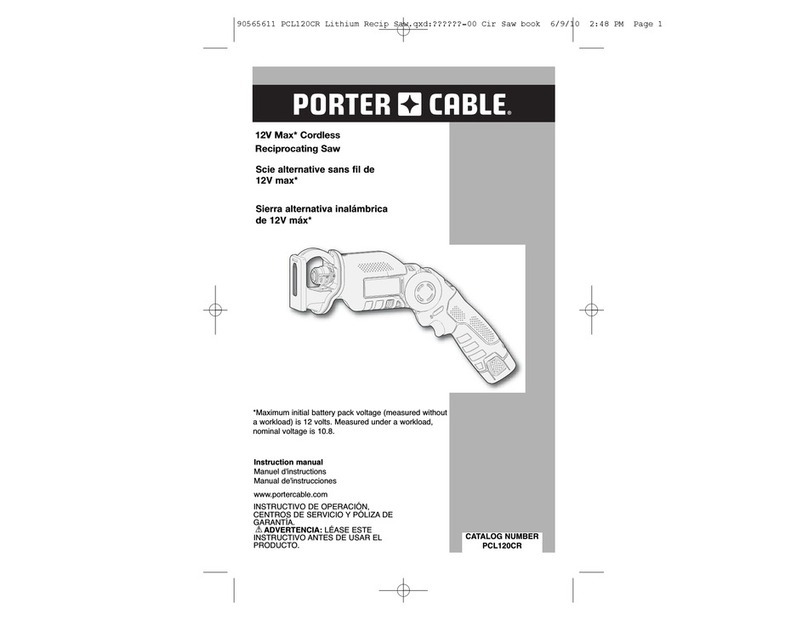
Porter-Cable
Porter-Cable Cordless Reciprocating Saw User manual
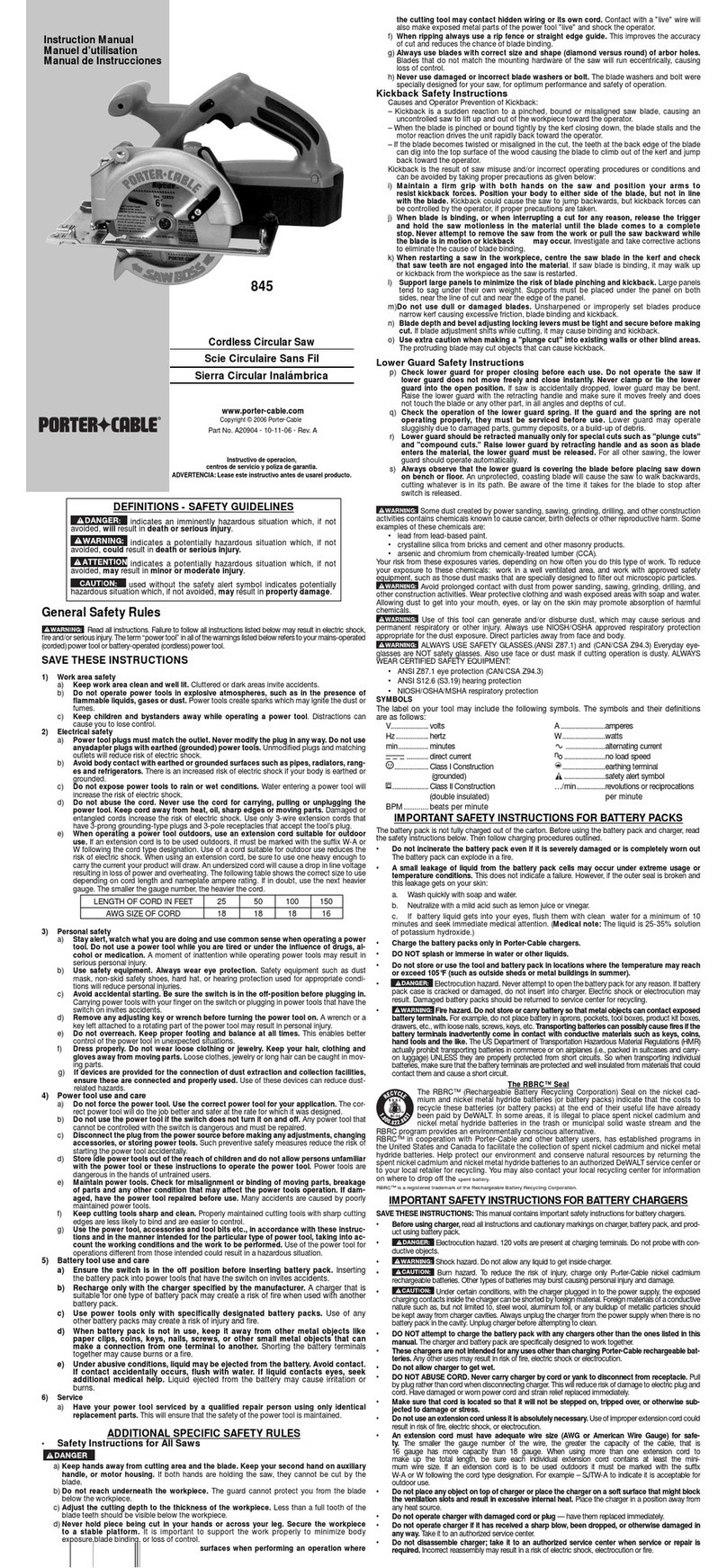
Porter-Cable
Porter-Cable 845 User manual

Porter-Cable
Porter-Cable 837 User manual

Porter-Cable
Porter-Cable 735 User manual

Porter-Cable
Porter-Cable 837 User manual
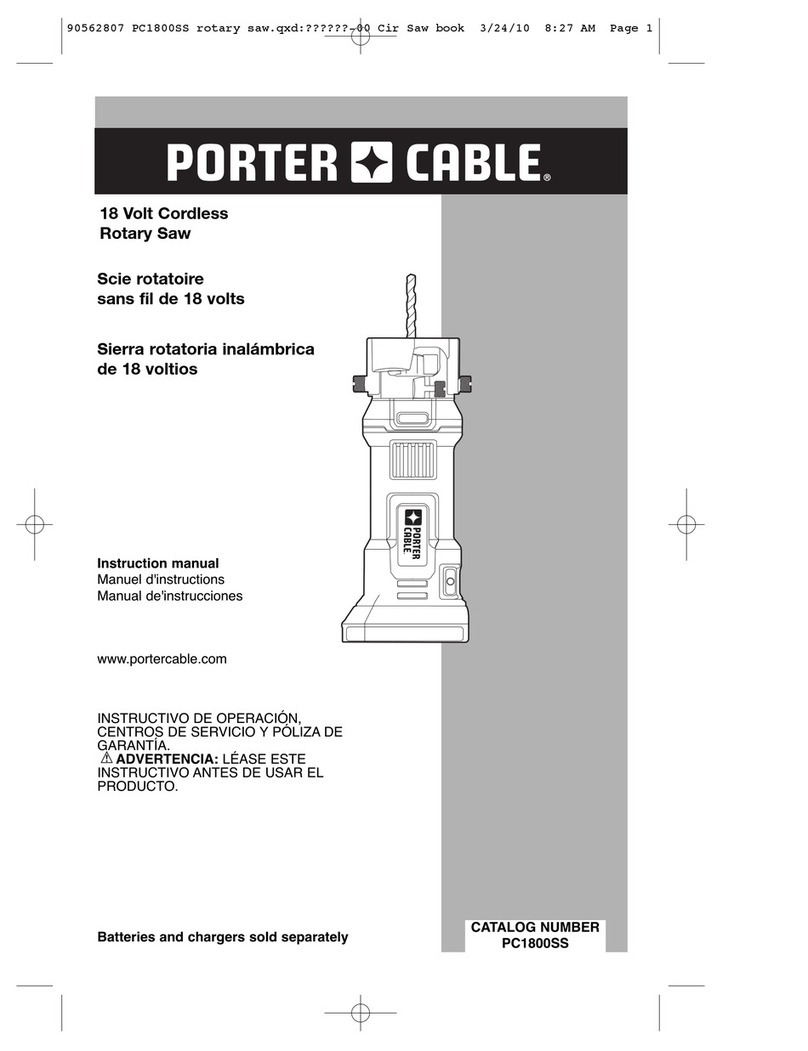
Porter-Cable
Porter-Cable 90562807 User manual
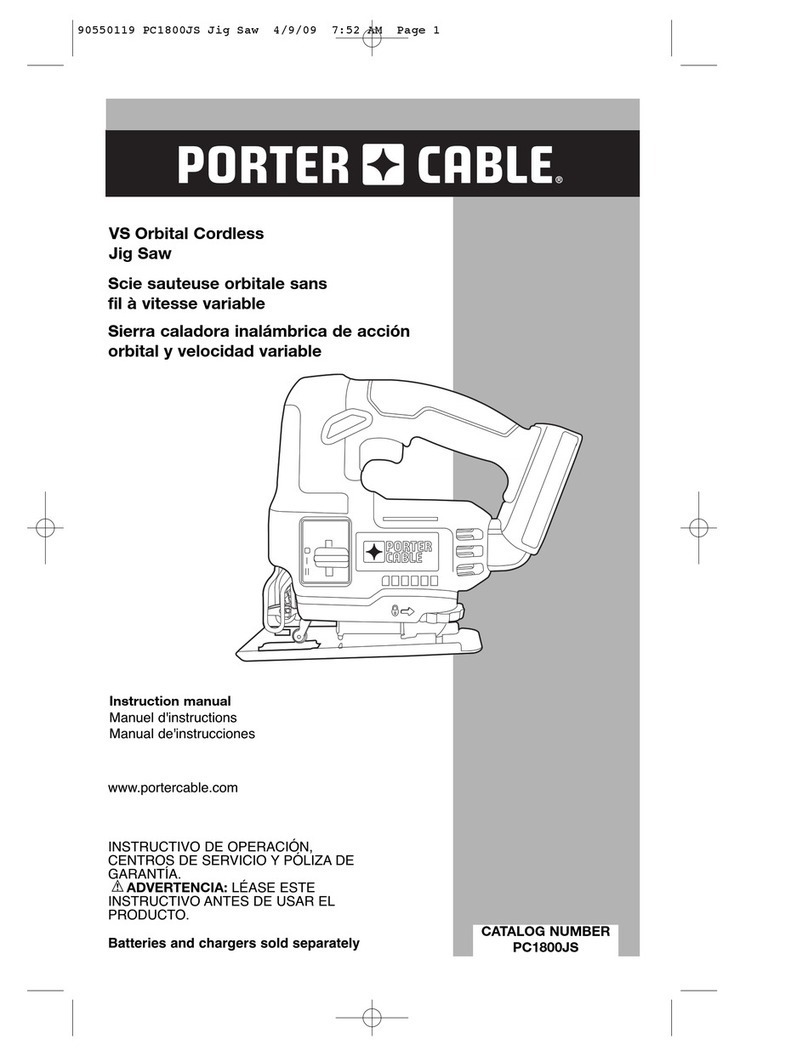
Porter-Cable
Porter-Cable 90550119 User manual

